1lumen selects and reviews products personally. We may earn affiliate commissions through our links, which help support our testing.
Astrolux FT05 review
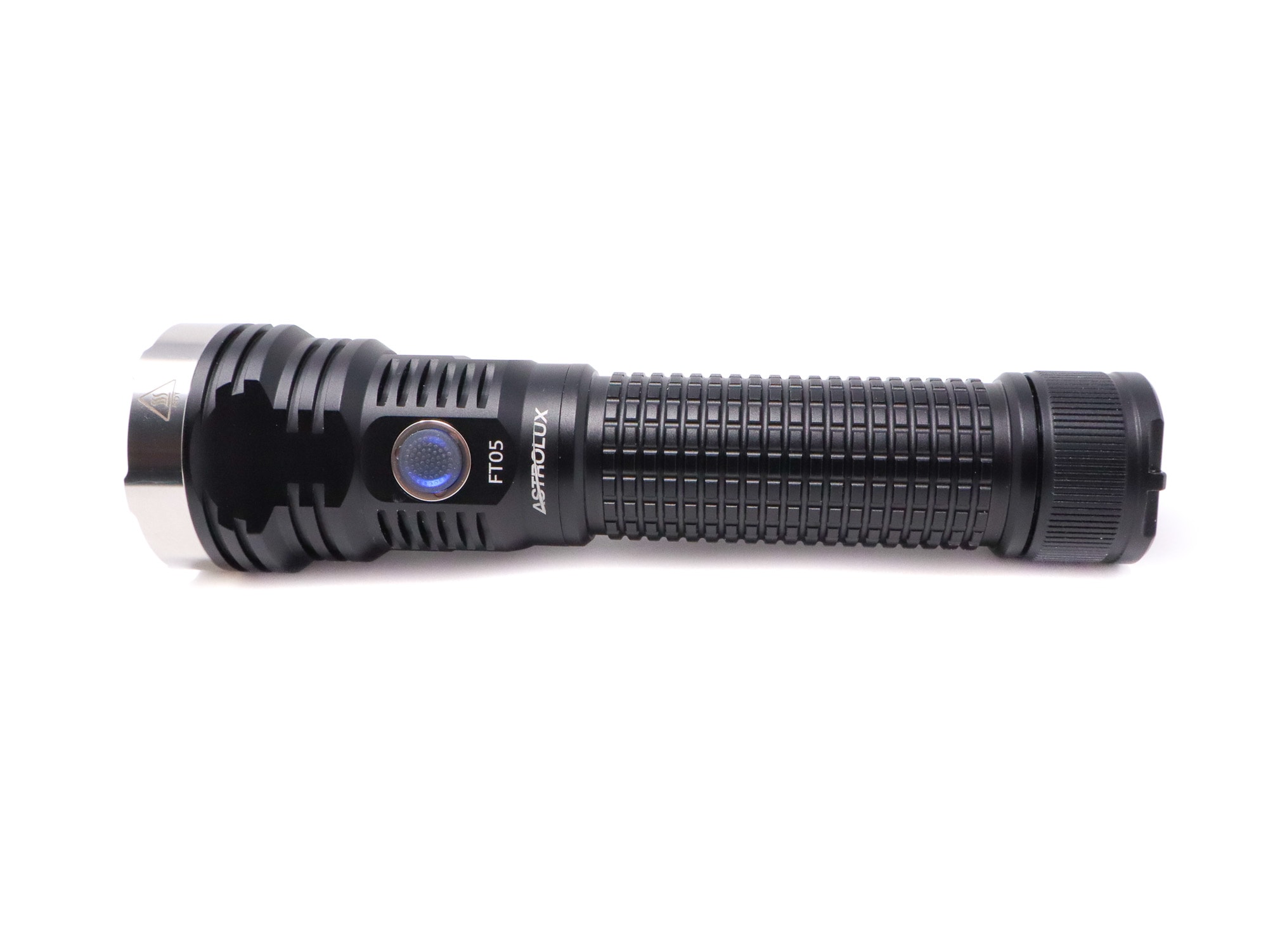
Astrolux FT05 specs
| Brand & Model | Astrolux FT05 |
|---|---|
| Flashlight category | General Purpose |
| LED | XLD HP50 HI |
| Max. output | 3,050 lumens |
| Max. beam distance | 711 meters |
| Max. beam intensity | 124,300 cd |
| Battery config. | 1*26980 |
| Onboard charging | USB C |
| Main modes | Smooth ramping |
| Blinkies | Strobe |
| Waterproof | IPX6 |
| Review publication date | January 2024 |
Review intro:
It’s been a while since an actual Astrolux has graced my desk, so I had a bit of nostalgia when I was asked to review the latest from our friends. Astrolux was a staple of Banggood’s flashlight enterprise, but now they’ve branched out a bit to other platforms, but you can still get them there. The FT series from Astrolux (part of Mateminco’s MT lineup) encompass general purpose and thrower-type and multi-LED high output flashlights.
This new one, the Astrolux FT05 (moonlighting as the Mateminco A1) carries that forward. It’s been a minute since we’ve seen a new FT series, and this one promises to be a bit special since it features a never-before seen battery in the flashlight space, unique LED, and big performance from a small-ish host. It’s an Astrolux, so I know what I’m getting into. Hopefully ‘special’ doesn’t turn out to be ‘quirky.’
Package quality.
Like most all the Astrolux lights I’ve reviewed, the FT05 came in a plain cardboard box with the brand name, and some stickers on the side with a graphic of the light and spec tag for color/etc. Inside, it’s some cut-to-shape foam and all the bits. Here’s what you get:
- Astrolux FT05
- Astrolux-branded 6000 mAh 26980 li-ion battery
- Lanyard
- User manual
- 2 o-rings
This is a complete, ready to go kit. You would want to fully charge the battery to get the most runtime and output, even though it came charged to 4.09 volts (pretty high for storage). There was a sick-on isolator sticker on the negative side of the battery, and even though I carefully peeled it off, it took some of the battery wrap with it. Booooo. The wrapper is low quality and brittle, and usually I’d re-wrap these right away, but since it’s a super oddball size, I didn’t have any suitable wraps so I fixed it with some clear tape instead. The lanyard is the typical one I see with Astrolux lights. Overall, besides the battery, no issues here and I’m glad to see 2 o-rings.
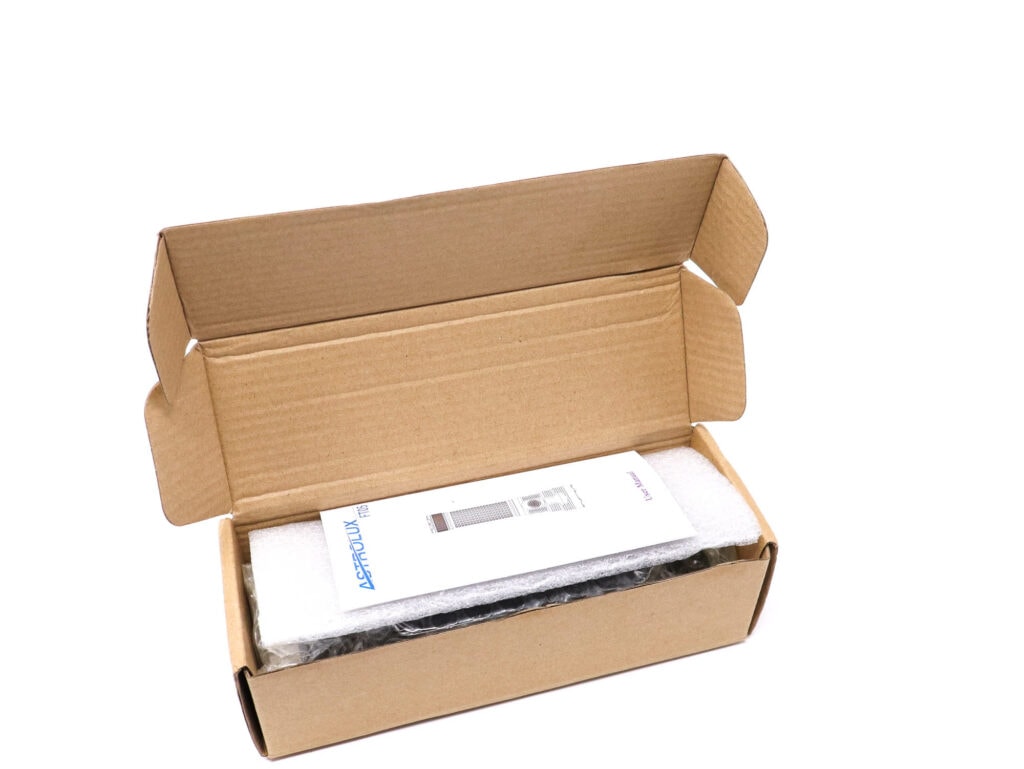
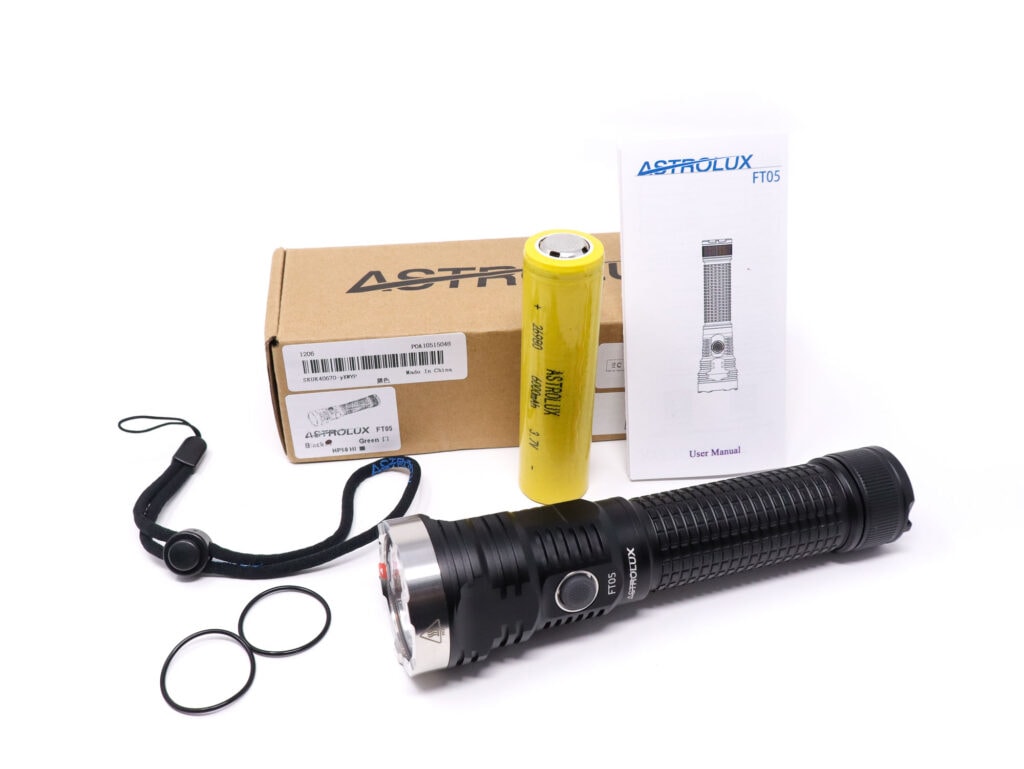
Flashlight in use, Build Quality, and Warranty
The Astrolux MF05 straddles the general purpose and thrower flashlights use case line. With 700 m+ advertised throw, I’d lean more towards thrower, but (spoiler alert), it’s a decent general purpose light. The form factor is typical tube light, with a longer-than expected body to accommodate that 98 mm long cell.
It’s as long as a 2D Mag, and about the same size as my Streamlight Stinger (the original). There’s lots of grippy blocks on the tube for a good secure purchase on the light, and it’s easy to control and comfortable to hold. For retention, there’s a lanyard hole on the tailcap that’s (no surprise) too small to thread bare-handed (or fingered) the included lanyard through.
There’s a magnet in the tailcap for sticking the light onto ferrous surfaces. I like magnetic tailcaps on MOST lights, but I think it’s a bit out of place here. The magnet is reasonably strong, but the light is so long and top heavy, it’s a bit unstable at a right angle and I don’t think I’d really use the FT05 as a utility light, but it’s nice to have that feature.
There’s a single e-switch at the head and I swear it’s the same exact switch we see on every Astrolux light made since 2018. That’s fine though since it’s a good one. The clicks are a bit soft compared to my other Astrolux products though, but still have good feedback. The boot is proud and super grippy and feels nice. It’s backlit with blue and red LEDs for on and charge state as well, and they stay on for standby, but can be disabled in the UI. Opposite the switch is the USB port. It’s covered by the same silicone rubber cover I’ve seen on other Astrolux products (no surprise there), and that’s totally fine since it’s thick, sits flush with the tube, and never unintentionally came open. I didn’t find myself trying to poke the charge cover either. Thanks to the lighted boot and proudness, the switch is easy to find by feel in the dark.
Astrolux are budget lights, and you get a lot for your funds with them. The quality is not going to wow anyone, but it’s adequate and acceptable for the price. That said, there’s one blemish on the FT05: A small nick on the edge of the reflector hole. It’s noticeable, but doesn’t affect the beam or performance of the light that I can tell. Still, it’s an issue. Otherwise, it’s fine. Prices for the FT05 vary from $60 US to around $40 on sale, and again it’s a good price for a somewhat unique light.
The FT05 is milled from high grade aluminum alloy, and the machining, fit, and finish are decent. There’s a good-sized gap between the tail cap and tube where the tail cap doesn’t seat completely. Otherwise, no other issues with fit and finish to report. The edges are all chamfered and smoothed, and the silkscreen text and laser-etched graphics are crisp and sharp with nice contrast against the finish. The MF05 comes in black and green anodizing. The review light came in black, and it’s advertised as type III HA anodizing. It’s not quite semi gloss, but it’s about what I see on Fenix lights these days.
Nothing’s glued, gooped or hot-snotted, so you can take the light completely apart if you so choose, which is nice. There’s 2 o-rings sealing the tailcap, a single o-ring at the front of the tube, and o-rings for the bezel and head. The charge port also makes a sound seal, and Astrolux says it’s good for IPX6, not the better IP68, but still good for temporary immersion protection. The tube front and rear threads are rectangular cut, fully anodized, well-lubed and reasonably smooth, but not the buttery smooth from some other brands. The battery tube is not reversible, and the back end has thicker walls than the front. For springs, the tailspring is a properly thick, gold plated unit, which is a departure from Astrolux’s dual-spring design I’m used to seeing. Up front, there’s a brass contact for the driver.
For the warranty, it’s largely dependent on who you buy it from. Banggood has a 7-day DOA guarantee, and for branded products, a 1-year warranty which covers the product for free repair, replacement, or refund.
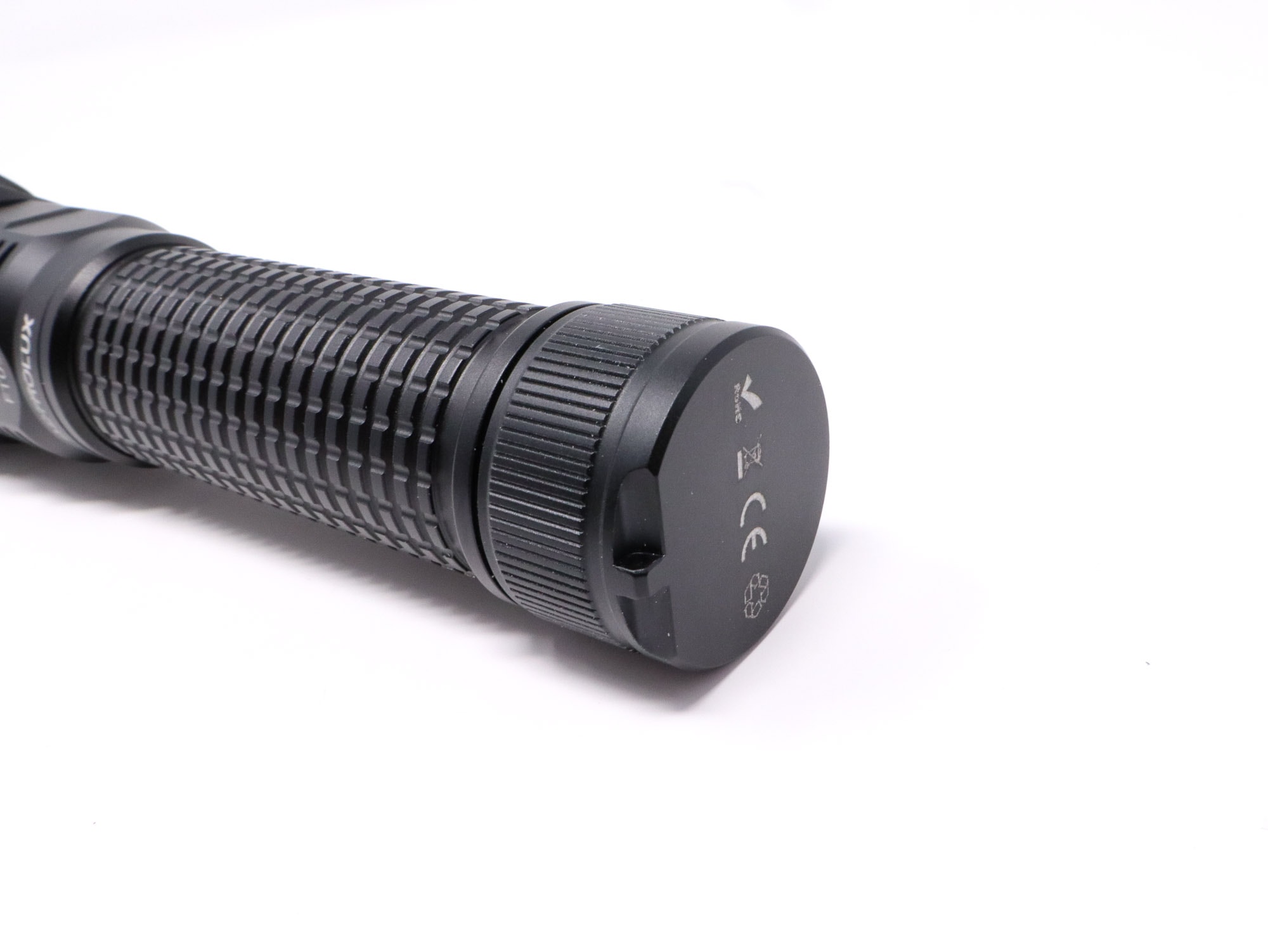
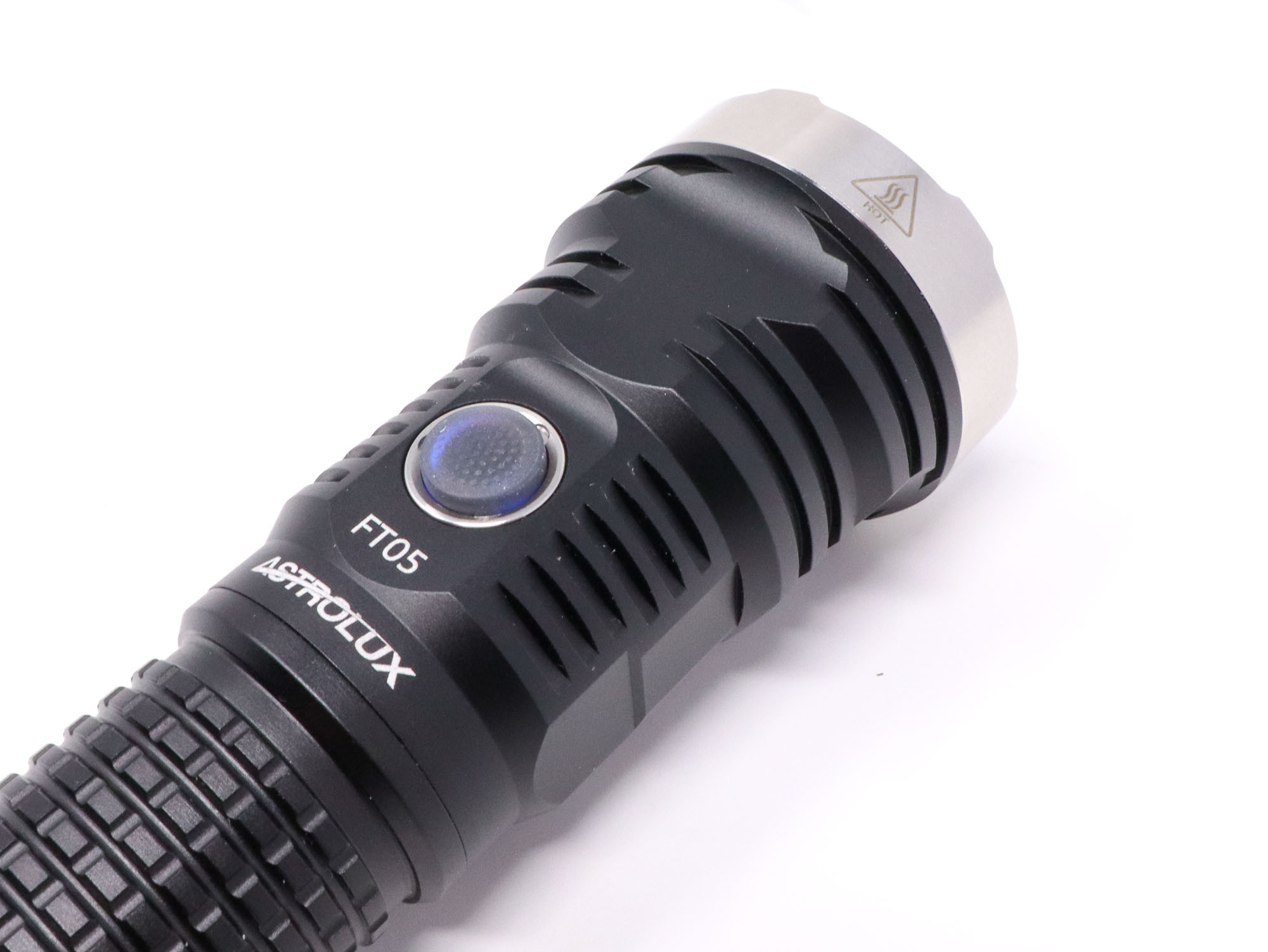
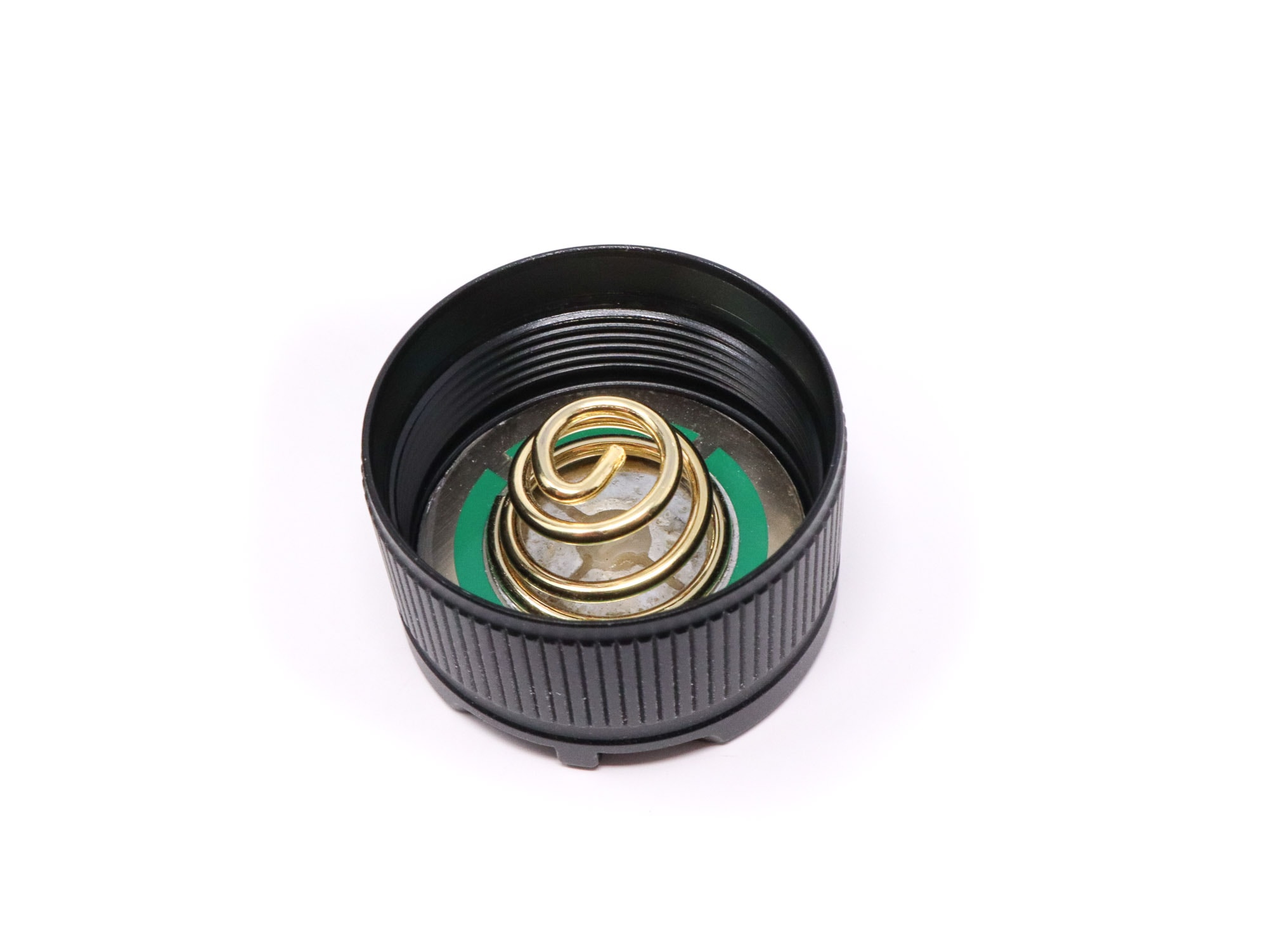
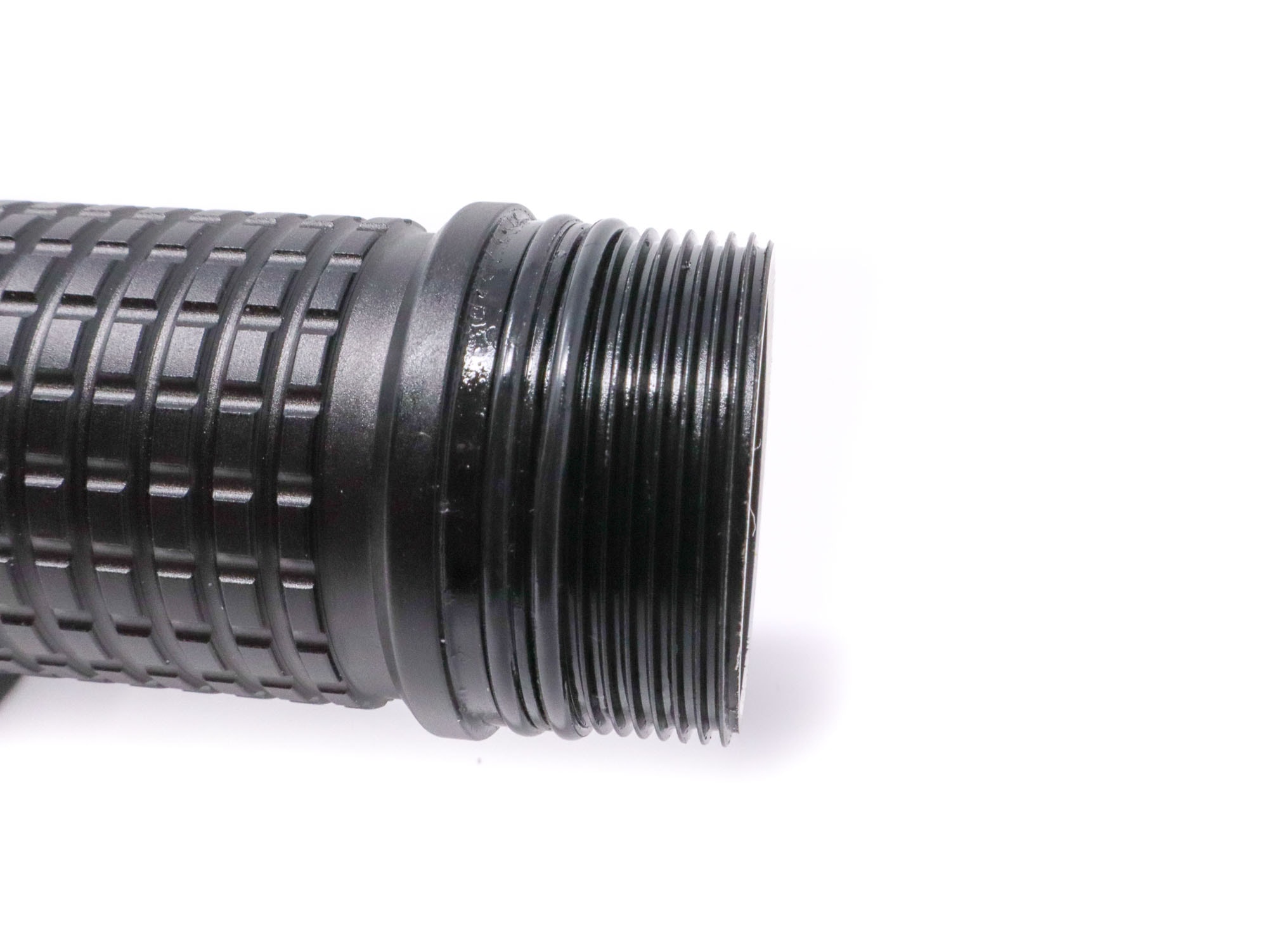
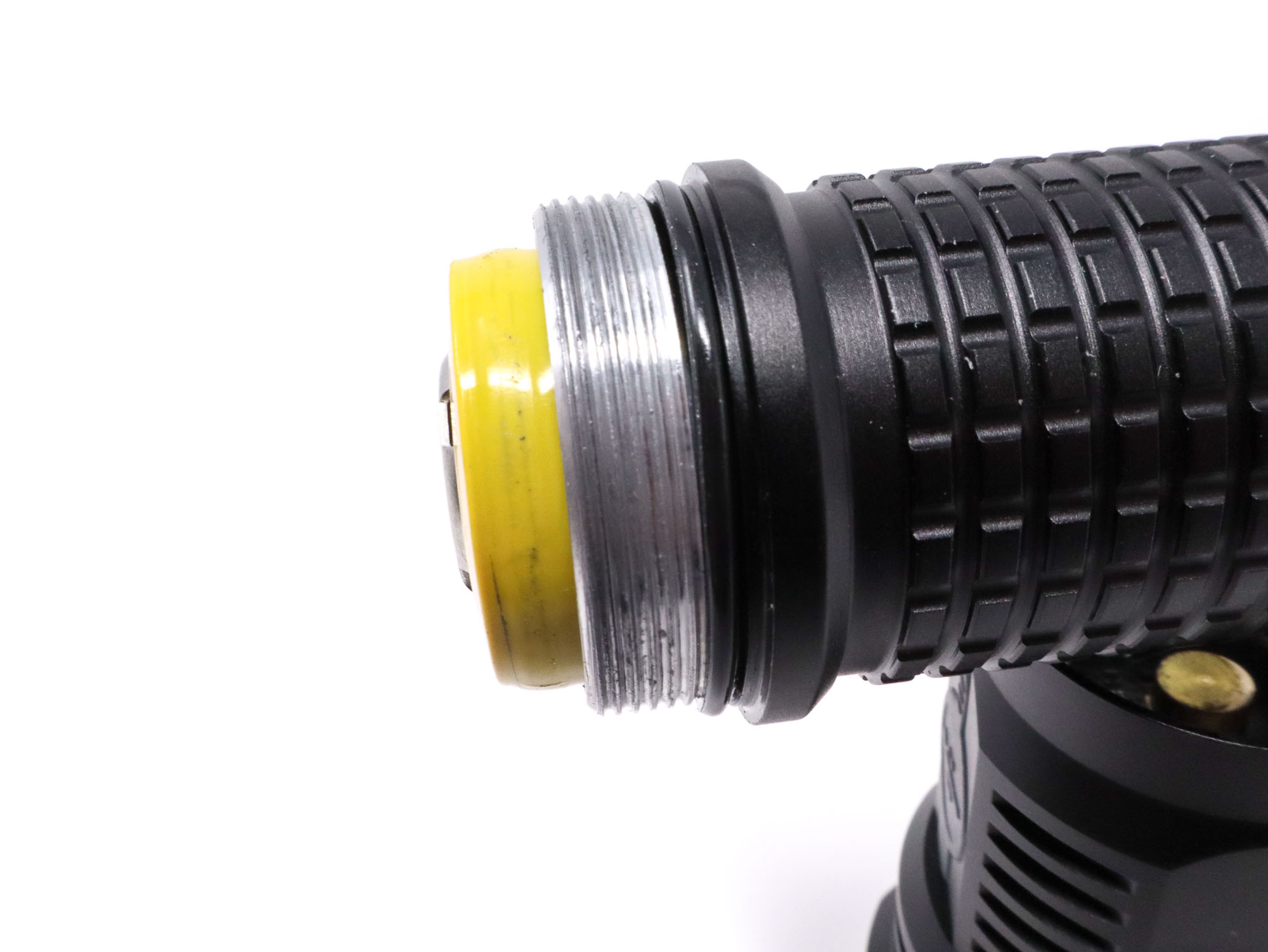
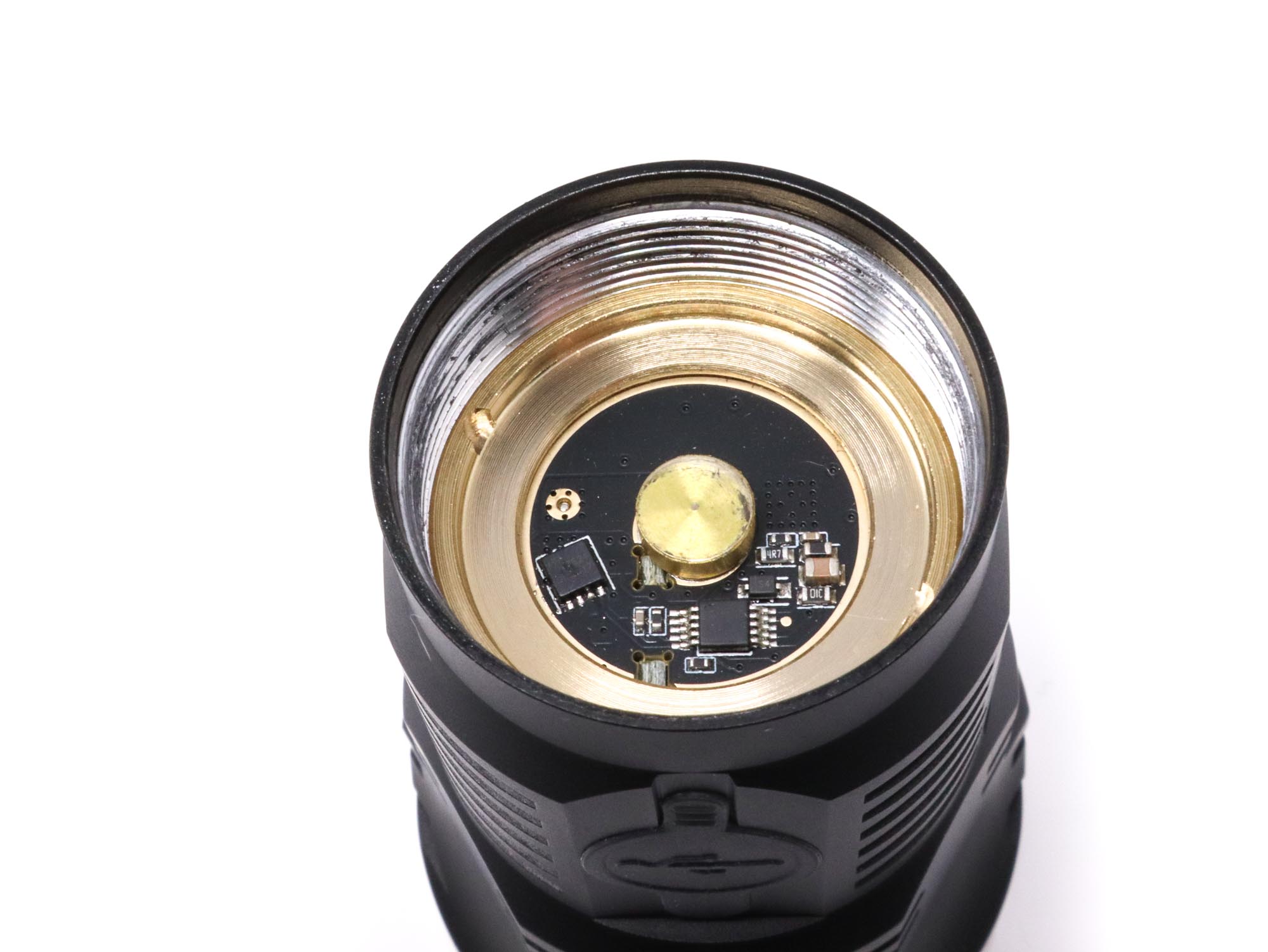
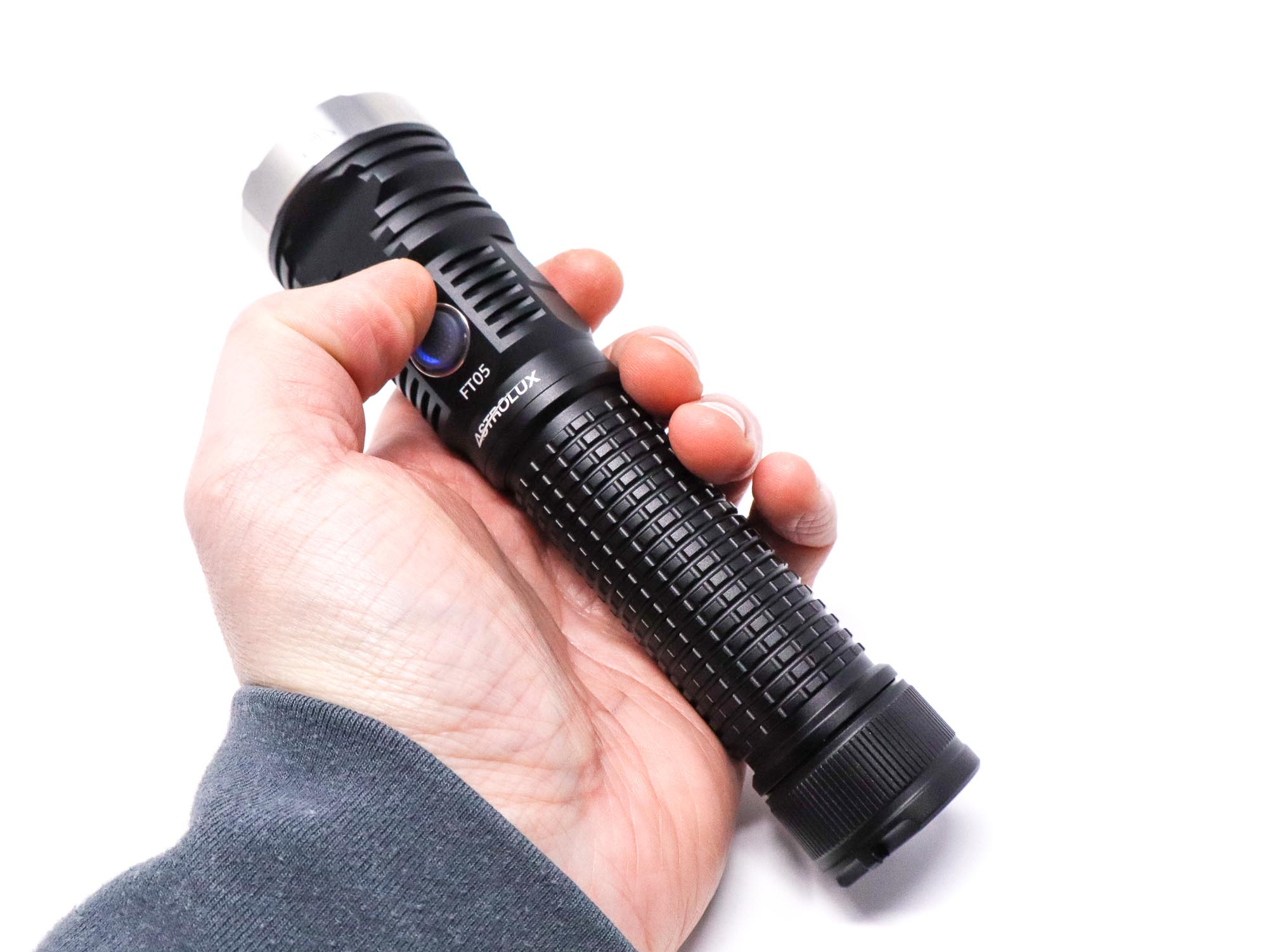
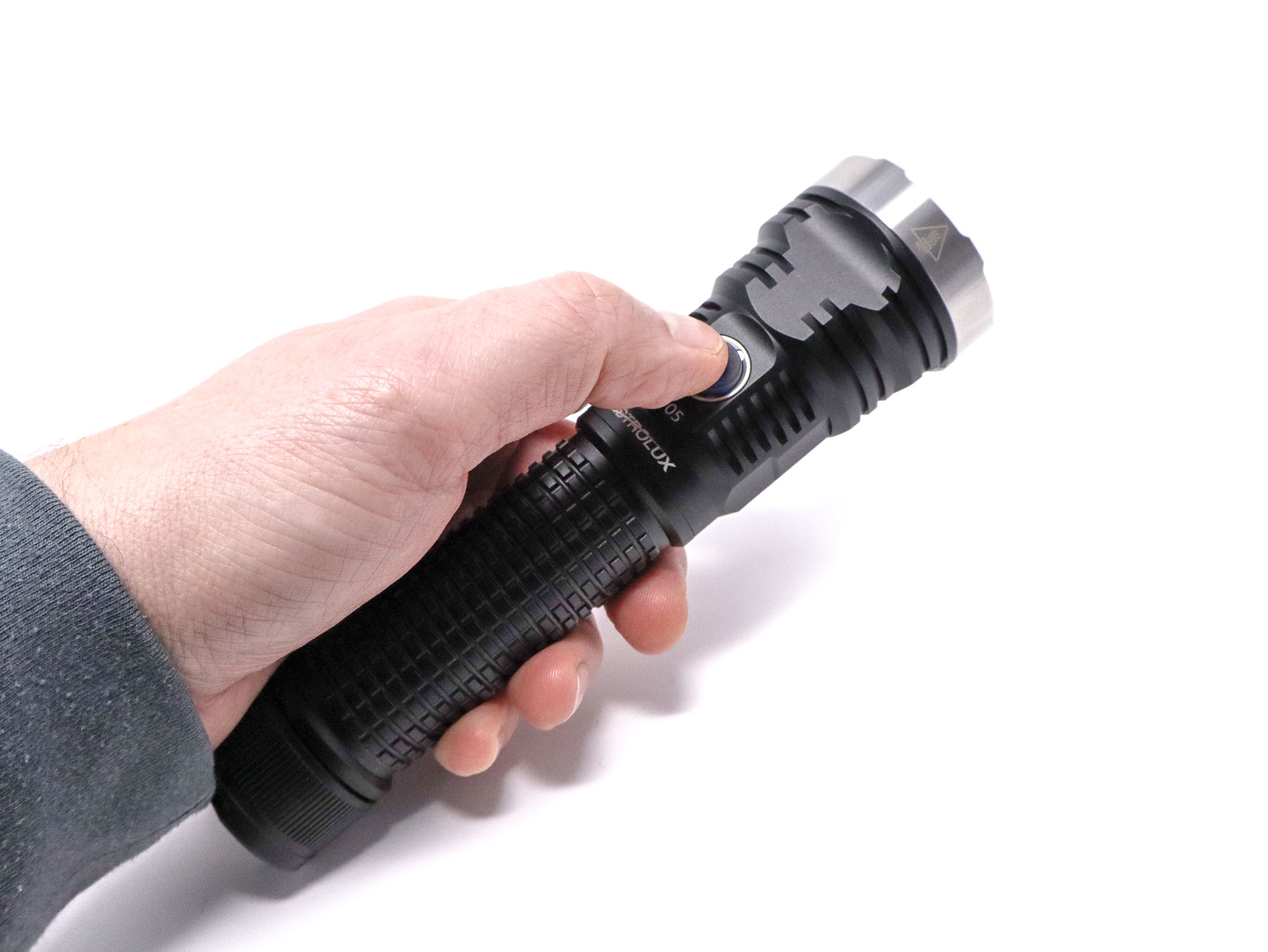
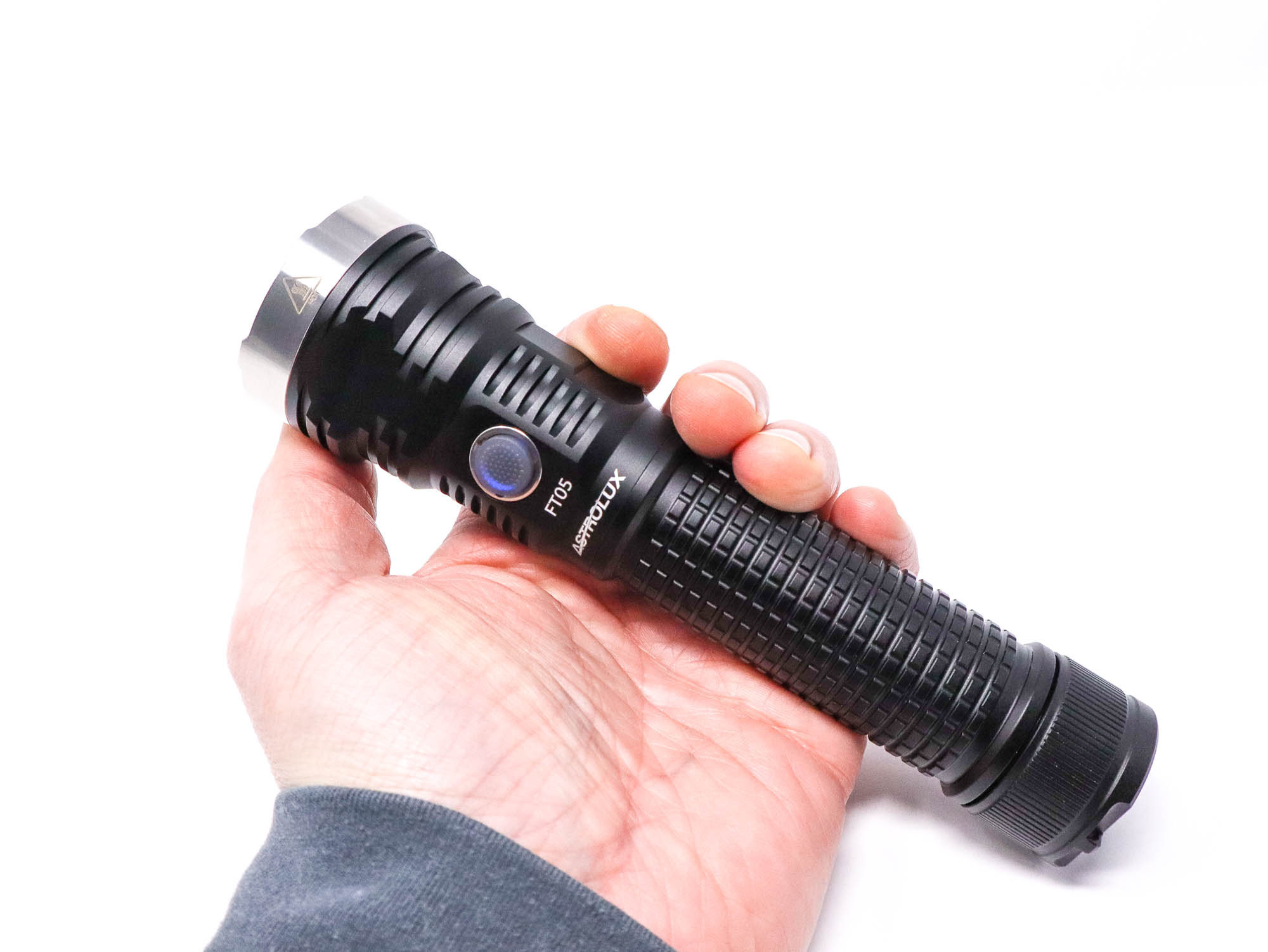
LED, Lens, Bezel, Beam, and Reflector
The LED unfortunately, remains anonymous, and this is the first time I’ve seen one like it used in a Astrolux product. I don’t know who makes it, and its specifications are just as nebulous. Koef3 over at the Budget Light Forum did a test on a similar LED (not the same) here: LED Test. The LED in question is designated as the XLD HP50 HI. While I don’t have manufacturer specifics, I can tell you that this is a 5050 (5 mm x 5 mm) footprint LED with a round die and no dome.
No dome, plus a small LES means high intensity for a lot of beam distance. It’s a bond wire design, so not the newer CSP configuration we see on Nichia and Cree’s newer LEDs, and it’s similar in design and construction to the Luminus SFT-40-W, with 4 bond wires embedded in a white substrate on the die. I’ve swapped two of these into zoomies with surprising results, and the ‘NiteLab UHi 40’ LED in the Nitecore EDC33 looks pretty much identical. If I were to guess, I’d say this was a San’an Optoelectronics product, but who knows.
Even without a datasheet with thermal resistance, vF, binning, T-case, or Lm/W figures, I will say this LED can be driven pretty hard and would also produce some high cd/mm2 (spoiler alert, it does), albeit at low efficiency and probably high vF. It’s cool white low CRI only.
Spectral measurements:
I used the Opple Lightmaster Pro to measure the flashlight at 1 meter from the sensor.
| Mode: | CCT: | CRI Ra: | duv |
|---|---|---|---|
| Turbo | 5896K | 61.6 | 0.0107 |
Like the other round die LEDs floating around, this one also shifts +duv and on the green side, even at high brightness. Not surprising at all, but it isn’t terrible and you wouldn’t notice it unless you were looking at a spectrometer, and it’s not as bad as the Leprechaun green LED in the Nitecore MH40S I tested.
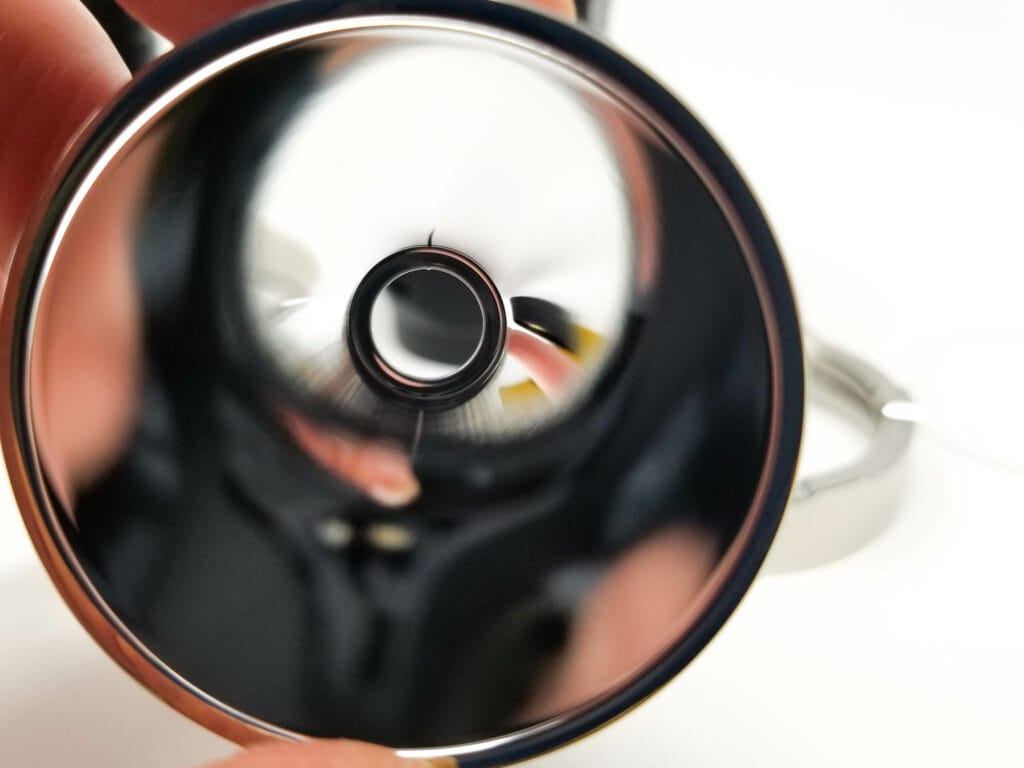
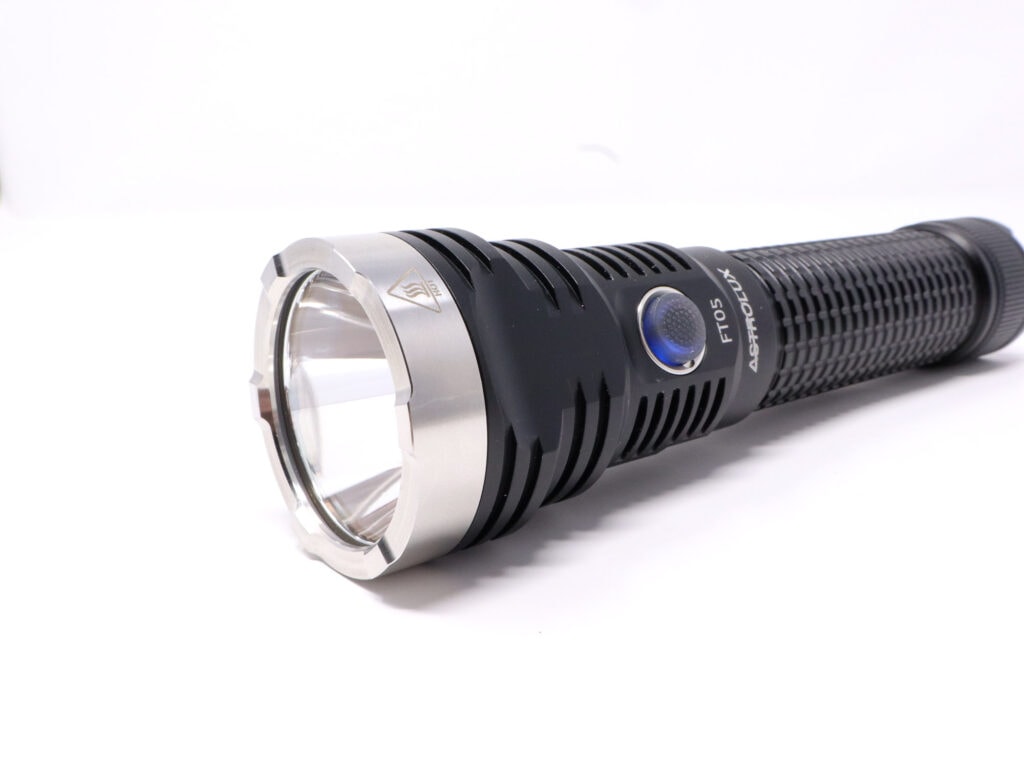
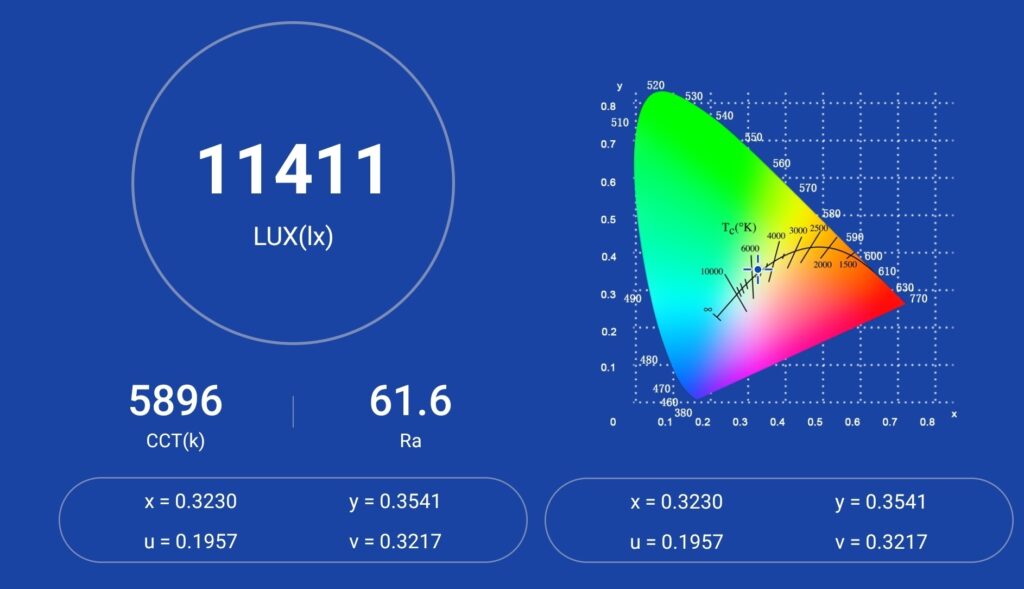
Dimensions and its competition
Dimensions:
| Astrolux FT05 | Millimeters | Inches |
|---|---|---|
| Length | 174 mm | 6.8 in |
| Head diameter | 46 mm | 1.8 in |
| Tube diameter | 34 mm | 1.3 in |
Dimensions are rounded to the nearest millimeter, and to the nearest tenth of an Inch.
Weight:
| Astrolux FT05 | Weight in grams | Weight in oz |
|---|---|---|
| Without battery: | 191 g | 6.7 oz |
| With battery | 327 g | 11.5 oz |
Weight is rounded to the nearest gram, and to the nearest tenth of an Oz.
Flashlight size comparison with its competition:
Group 1 left to right: Streamlight Stinger (original), Astrolux FT05, Nightwatch NI03 Valkyrie, Streamlight Stinger 2020
Group 2 top to bottom: Olight Warrior X4, Astrolux FT05, Wukkos TD01C, Fenix TK20R UE, Cyansky K3 V2
Group 3 reflectors left to right: Astrolux FT05, Nitecore MH40S, cheap zoomie with 5050 LED
Group 4 reflectors left to right: Astrolux FT05, Fenix PD35 V3 with Luminus SFT-40-W
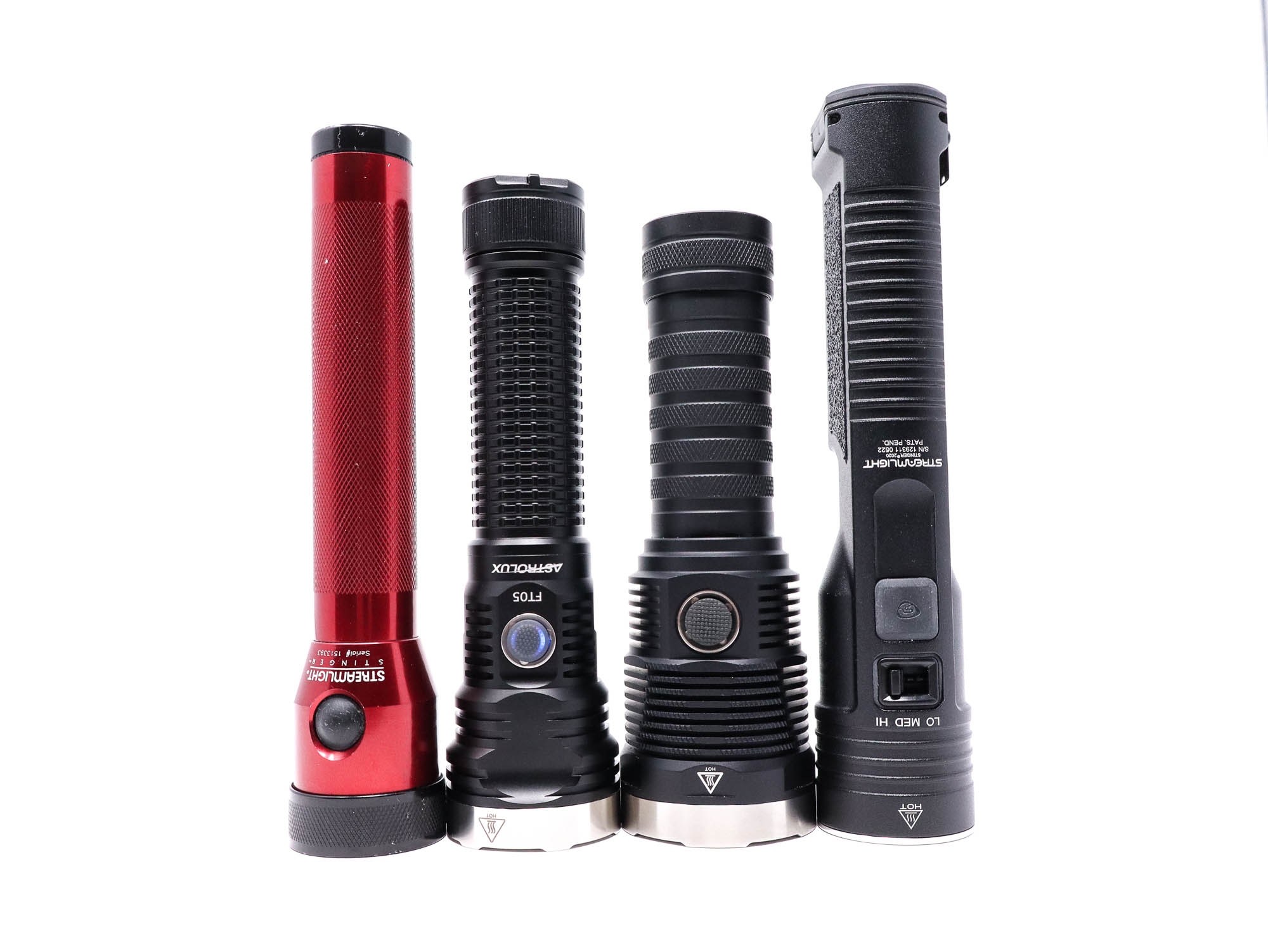
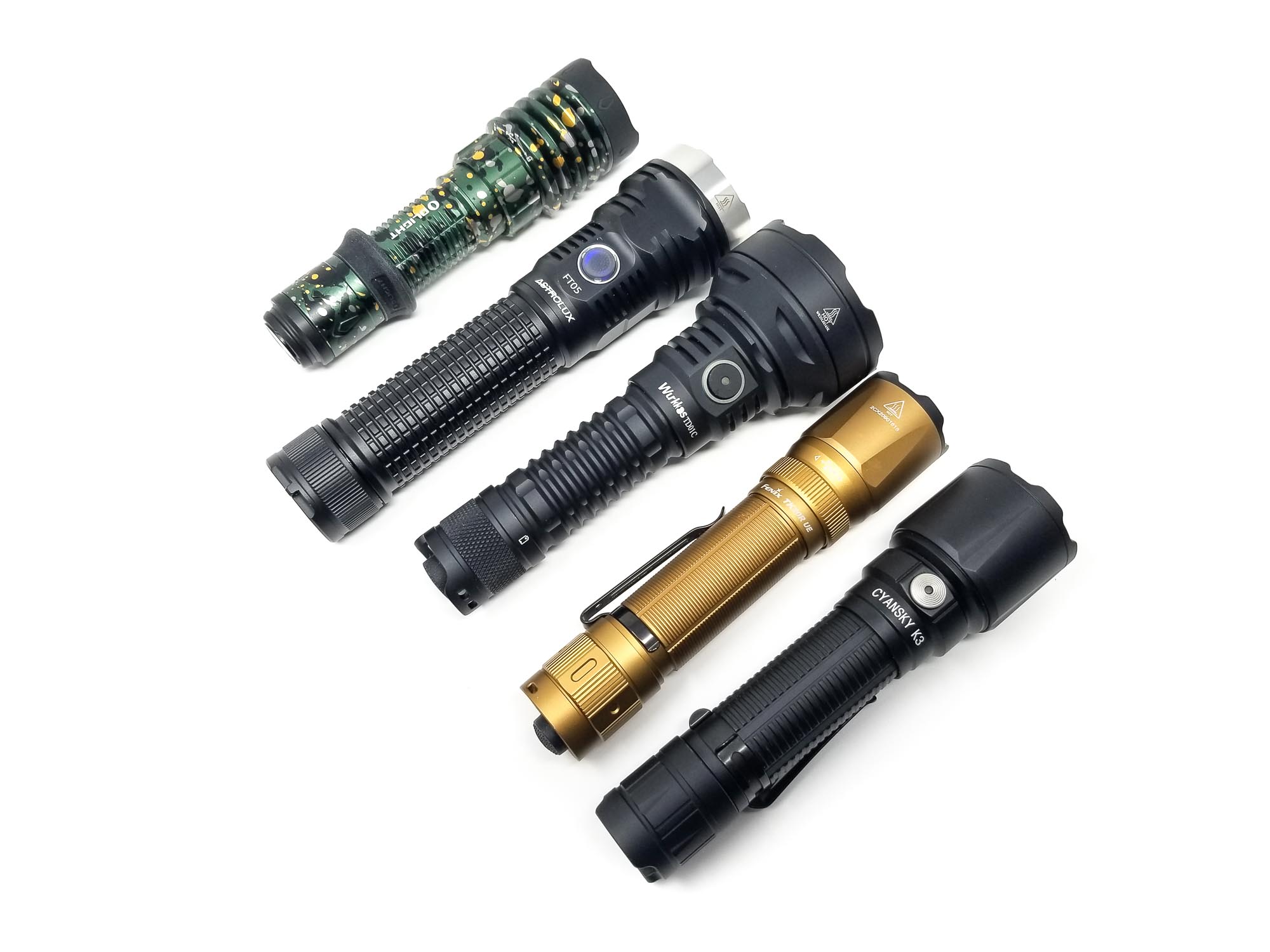
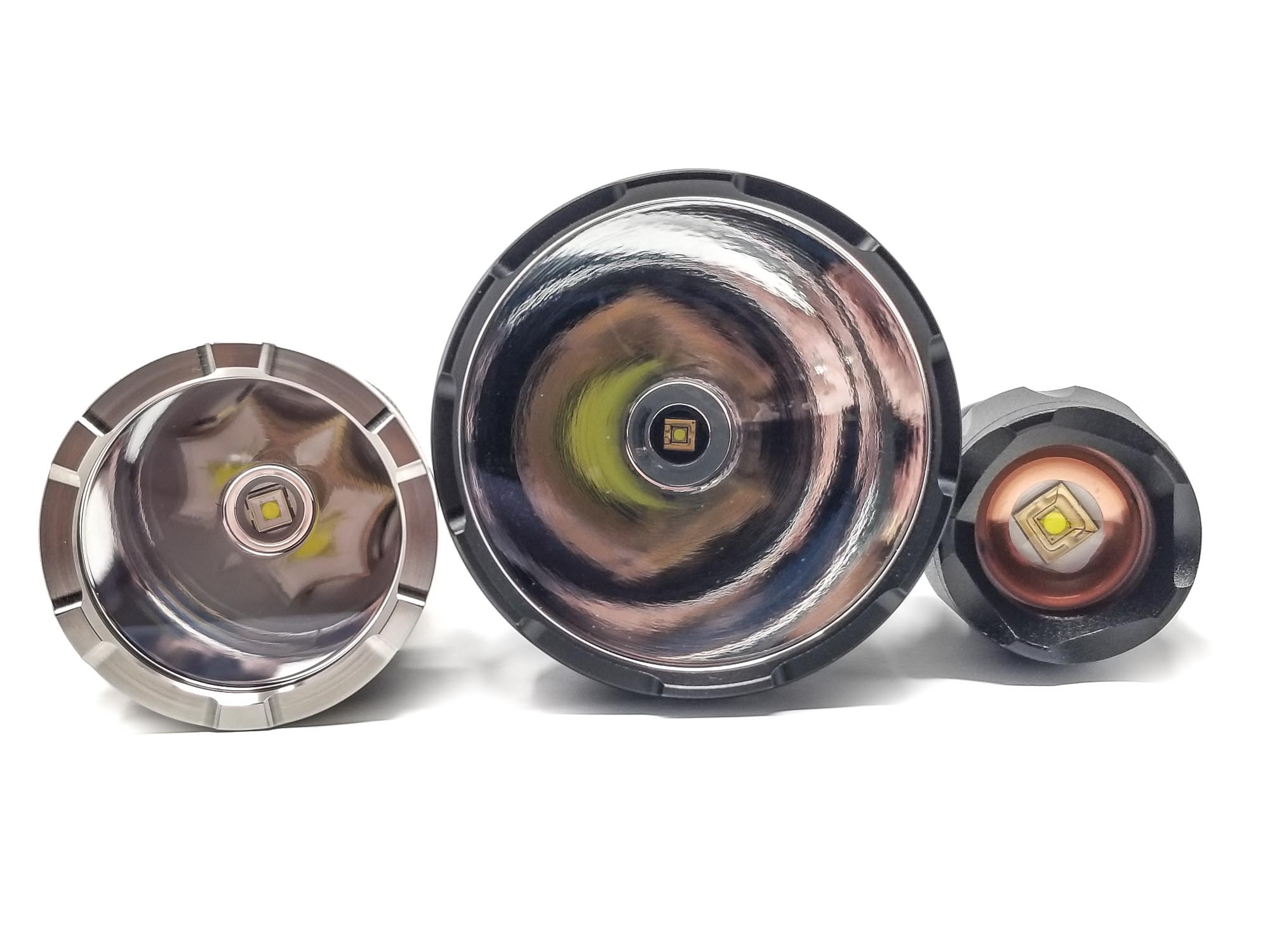
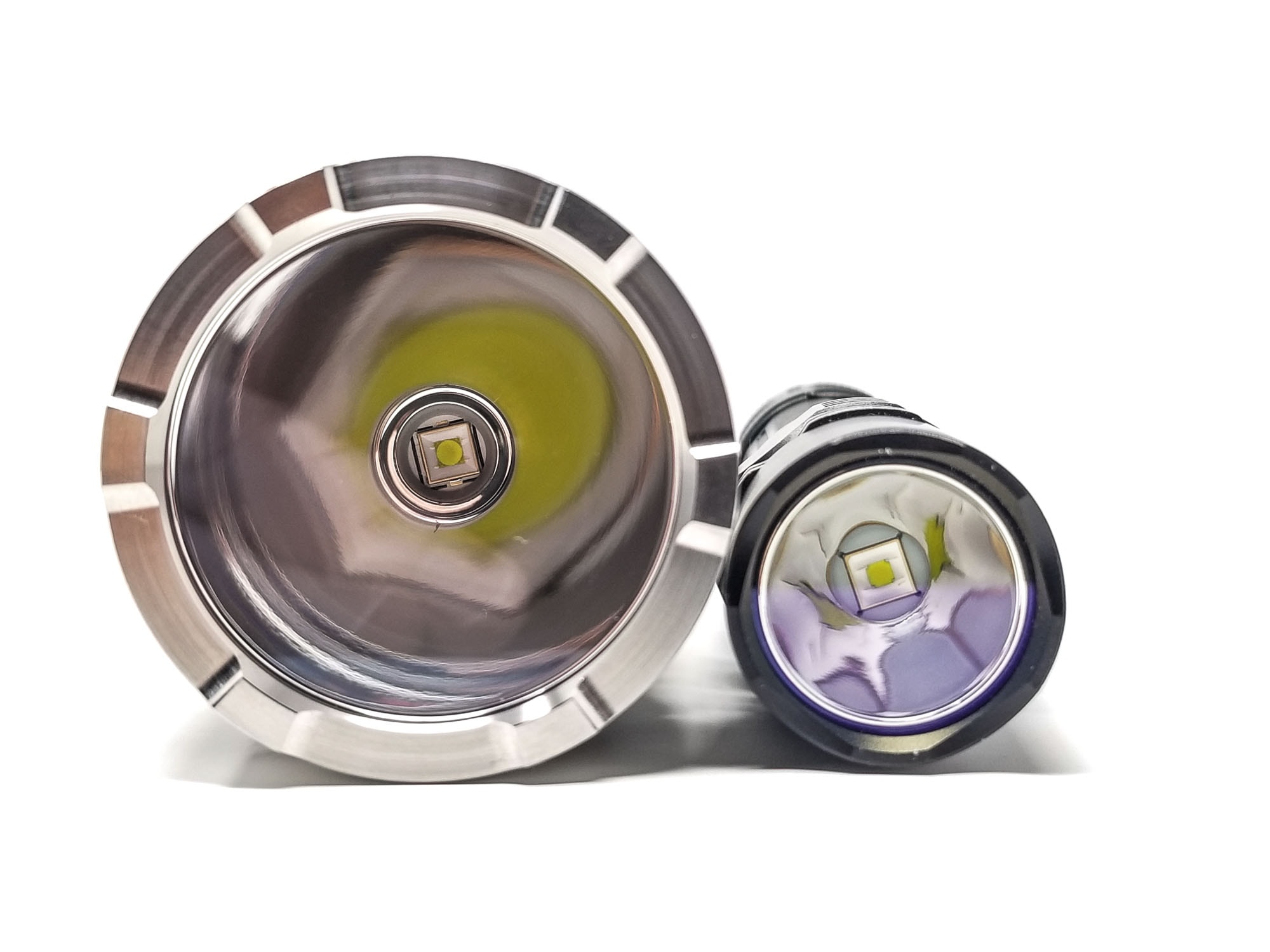
Astrolux FT05 UI: User Interface and Driver
The driver is a linear FET driver, basically a PWM controlled switching MOSFET. These are common in cheaper flashlights because they’re…well, cheap and easy to manufacture. Plus, they guarantee maximum output that tracks with the battery voltage, so as the cell drains, the output goes down. Not ideal and definitely not the best way to drive an LED in a handheld flashlight, but it works.
The UI is a smooth ramping affair with a Low (bottom of ramp), High (top of ramp), Turbo, and Strobe mode
Available modes:
- Smooth ramping with Low (bottom of ramp), High (top ramp), Turbo
Available blinky modes:
- Strobe
From OFF:
- Single click: Turns on in last used brightness
- Press and hold switch: Turns on
- Double click switch: Turbo
- Triple click switch: Strobe
- 4 clicks: Battery check
From ON:
- Single click: Turns off
- Press and hold switch: Ramps brightness up. To ramp down, release and press and hold
- Double click: Turbo
- Triple click: Strobe
Mode memory:
- Yes. Remembers the last-used brightness level. Turbo is not memorized
Shortcuts:
- Double click: Turbo
- Triple click: Strobe
- 6 quick clicks will turn off the switch LED
Low voltage warning/protection:
- The switch LED indicated battery state when turned on: Solid blue for
Strobe/blinkies
- Strobe, a triple click will activate strobe
Lock-out mode:
- Yes, electronic lockout or manual lockout. From off, 5 quick clicks activates the lockout. Repeat the unlock. Unscrew the tailcap ¼ turn for manual lockout
PWM
- None visible by eye, but very fast PWM viewable on the camera
Additional/summary info on the UI:
- This is a fairly standard ramping UI with some goodies built in. I like the batt check and electronic lockout, and being able to turn off the switch LEDs is also nice. All the Anduril fans will probably be a bit sad here, but honestly, I think this UI is just fine for the FT05. The only things they could do better? The ramping algorithm needs refining, and honestly, I’m a bit spoiled by Anduril’s nicely linear ramping, and this is my complaint with many non-Anduril ramping UIs, so I digress. Astrolux says there’s intelligent temperature management built-in.
Astrolux FT05 Charging and batteries
Here’s where the Astrolux FT05 strays from the crowd a bit. Instead of going with their usual fodder of 26650 or 21700, it seems like Astrolux thumbed through the Chinese battery catalog. What they came up with is a never-before-seen battery for handheld flashlights, the 26980. This is a 26 mm diameter, 98 mm long li-ion cell, so take a 26800 and stretch it another 19 mm and you have a 26980. It’s long, (longer than the 46950) flat top, and unprotected. My guess is this started life as an industrial application battery. It’s rated for 6000 mAh, so more than you get from a 21700 and a standard 26650, and it’s encroaching on 26800 territory.
There’s one issue with this cell, and that is it’s a pretty obscure size, and there’s no adapters and I didn’t notice an optional shorter tube available, so you’re pretty much stuck with this battery. when it goes bad, you’ll be looking for a spare. However, thanks to some tinkering and brainstorming, I found there is a workaround because the FT05 will lego with other 26650 size Astrolux tubes. I was able to lego with the EA01 and LT40’s battery tubes, and they worked, but didn’t fit perfectly to the FT05 head, so there was a slight gap. However, I’m not giving a concession here, and this is still a strike on the FT05 since it’s contingent on having spare tubes.
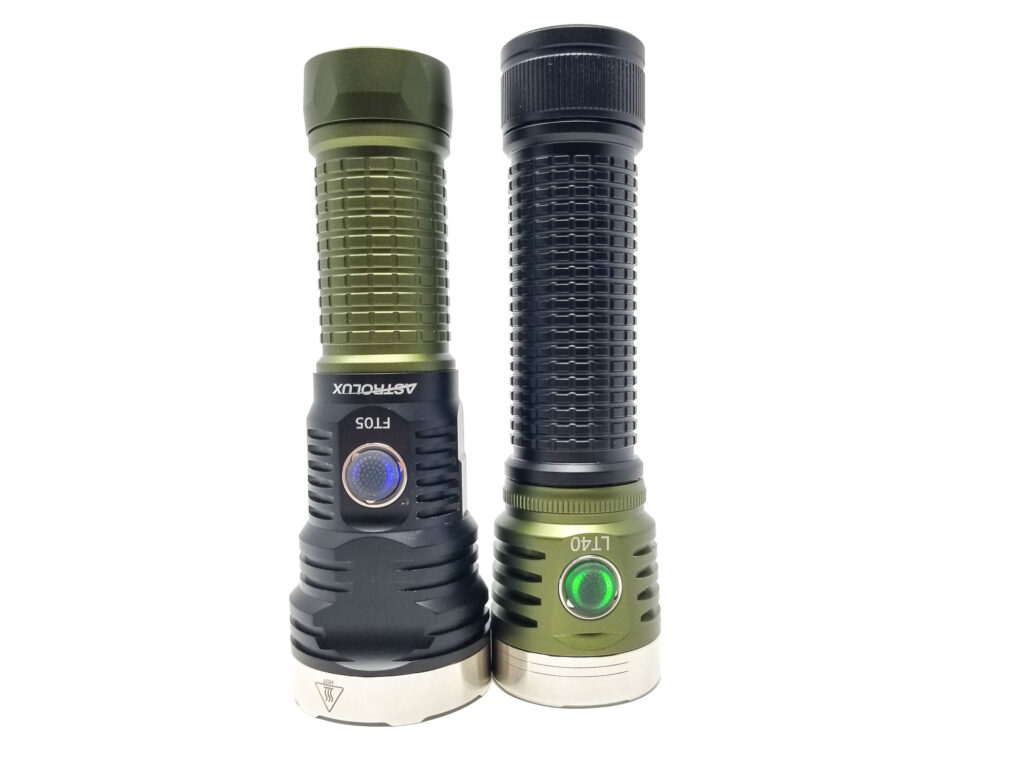
For charging, you get onboard USB type C bidirectional charging, so you can use all those mAh’s for recharging your USB devices (you do need a type C to type C cable though…not included). Astrolux says it’s good for 5 v 3 a max, or about 15 W. On the Hidance USB C tester using a C to C cable I saw around 13 watts, and only about 10 watts on a USB A to C. On the power bank side charging up the Thrunite Catapult Pro, I’m seeing about 12 watts. The cell took 5018 mA after a runtime test, so less than the 6000 mAh Astrolux advertised. That’s not that great all things considered, about 18.8 Wh for a 98 mm long cell. A high capacity 21700 pushes almost 18 Wh in a much smaller size.
Astrolux, if you’re reading this, please make a short tube for this light!
| Charge type | Fits | No fit | Charge time |
|---|---|---|---|
| USB type C | Included cell only | Everything else | 2 hours 34 minutes |
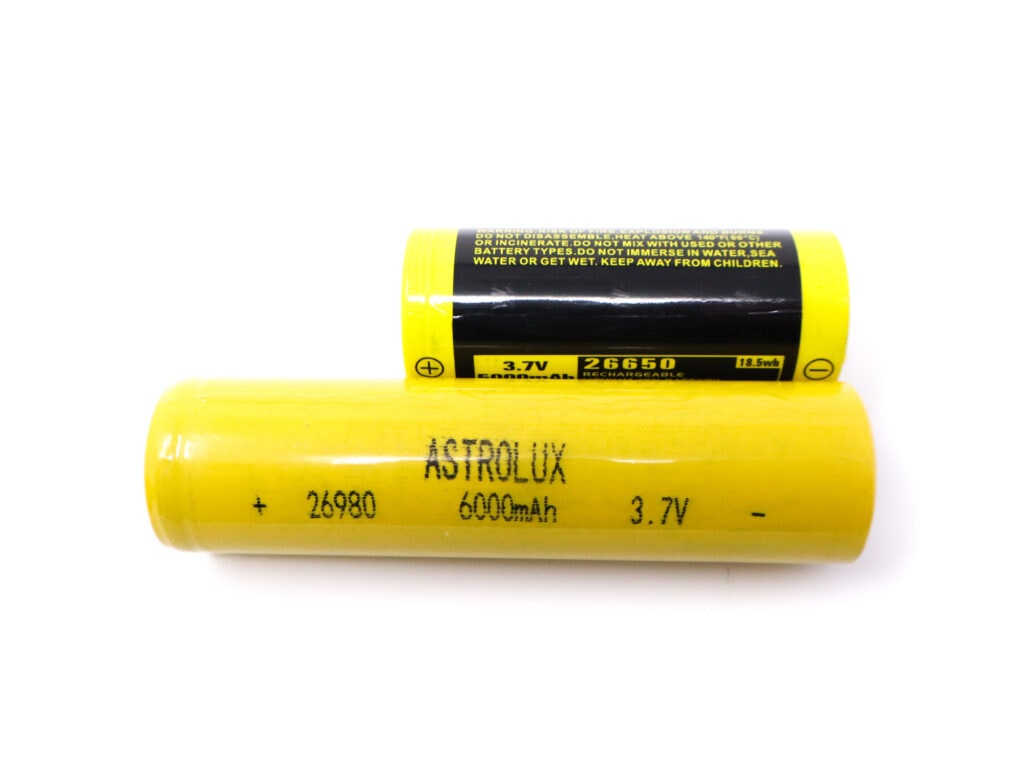
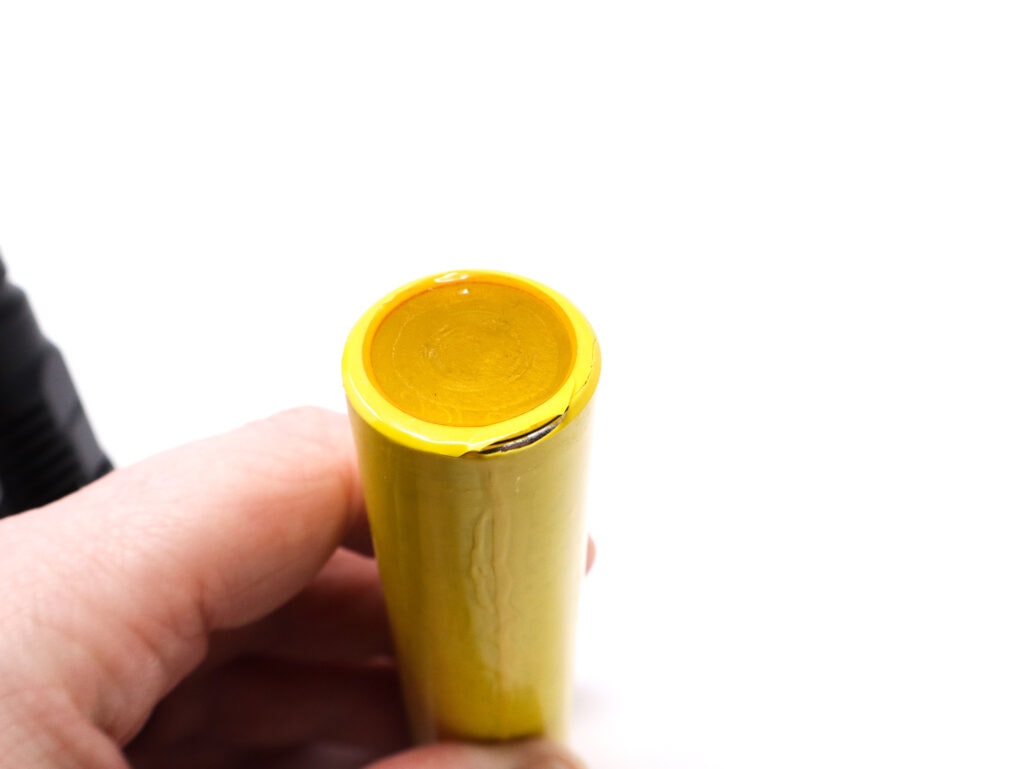
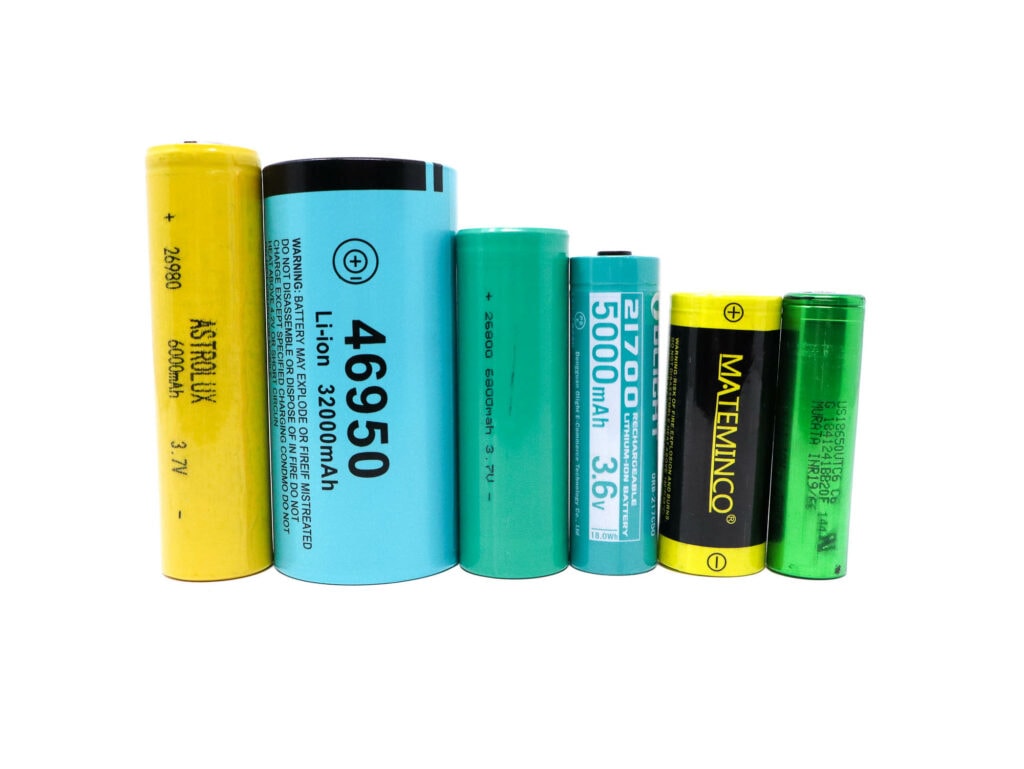

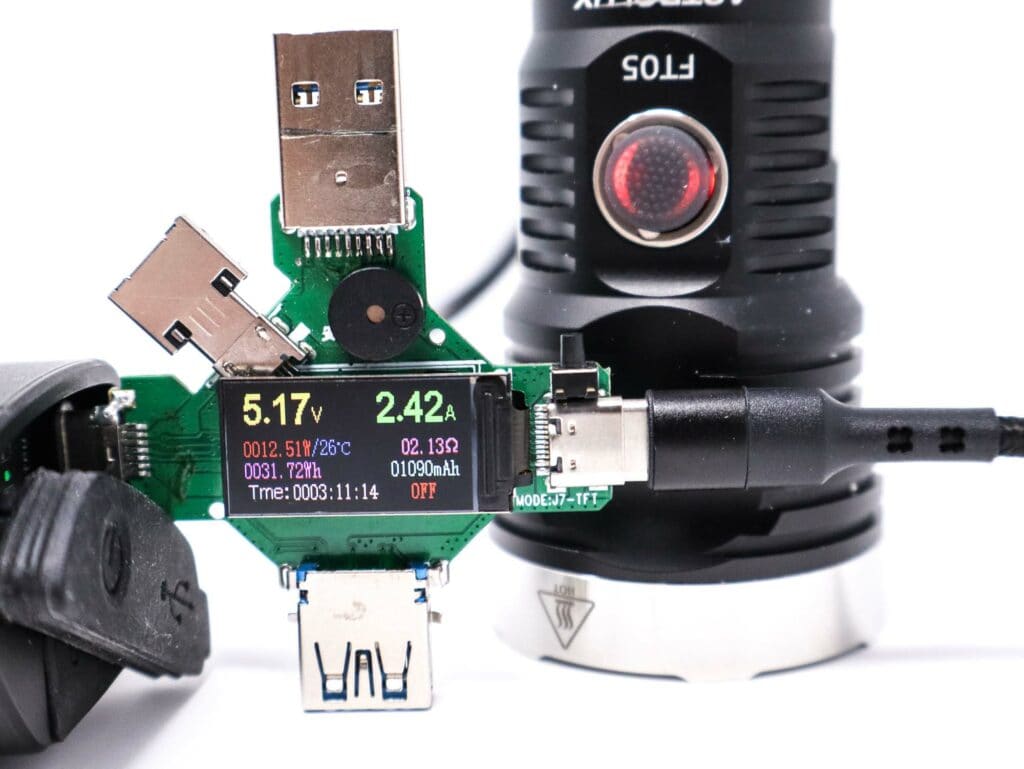
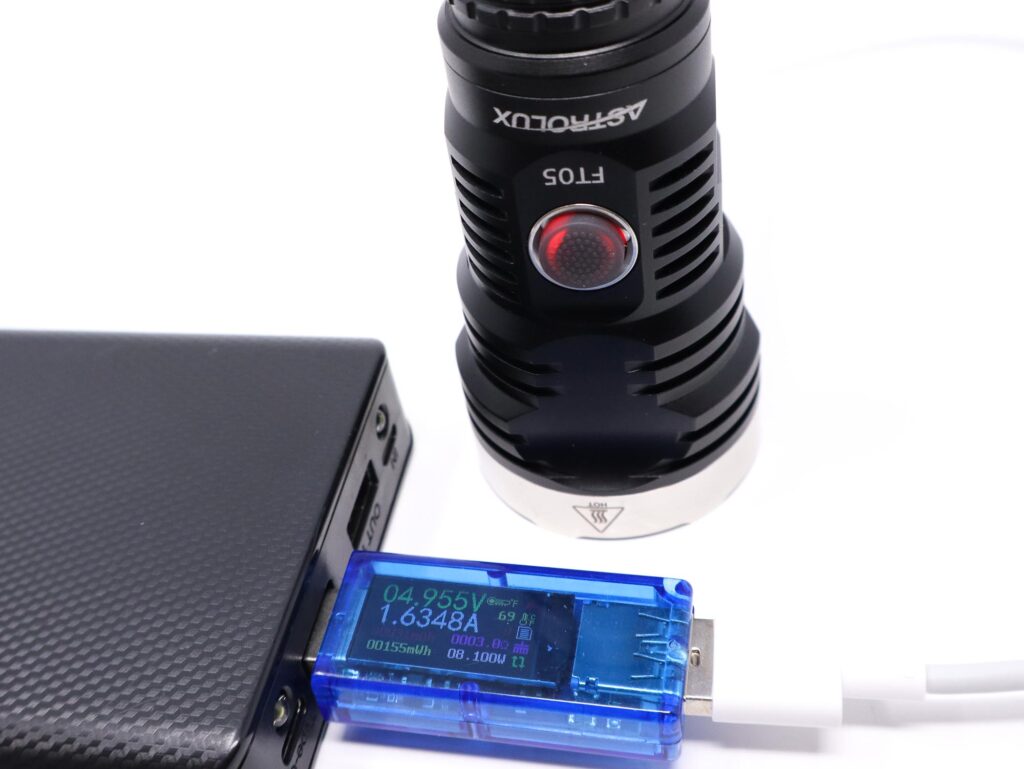
Performance test
Lumen measurements
How Lumens are Measured: Understanding ANSI FL1 Standards How Lumens are Measured: Understanding ANSI FL1 Standards: The ANSI FL1 standards specify that output in lumens should be measured 30 seconds after turning on, as this is the standardized time for measuring brightness according to the industry standard. This is why we focus on this part in our measurements. The ANSI FL1 standards require an ambient temperature of 22 ± 3°C. We record the ambient the ambient temperature to identify potential reasons for any observed discrepancies.Lumens are measured in my 50 cm integrating sphere with a Digi-Sense 20250-00 data logging luxmeter. The sphere has been calibrated with a Convoy S2+ measured to 260 Lumens and the figures are within 10% of actual. Current is measured with my Thinsinde B18+ multimeter with 14 gauge wire on banana plugs and my FY219 clamp meter for higher current over 200 mA. Measurements were taken using the included fully charged 6000 mAh 26980 battery. I added a measurement from what looked like 50% in the brightness ramp.
| Mode | Amps at Start | Specs | @turn on | @30 sec | @10 minutes |
|---|---|---|---|---|---|
| Low | 140 mA | ? | 3.7 lm | 3.7 lm | – |
| High | 8.25 A | ? | 1722 lm | 1660 lm | 480 lm |
| Turbo | 12.3 A | 3050 | 2608 lm | 2374 lm | 745 lm |
| 50% | – | N/A | 455 lm | 455 lm | 430 lm |
Parasitic drain:
- 0.56 mA
Of note here, the startup standby current jumped to 508 mA for 5 seconds before dropping to 0.56 mA. The LED is being driven pretty hard on Turbo mode, over 30 watts, which is about the same as a 6 volt XHP50.3 or SFT70. The output is pretty good and tracks with an SFT70 or XHP50.3 HI.
Astrolux FT05 Battery Life: Runtime graphs
How Runtimes are Measured: Understanding ANSI FL1 Standards About ANSI FL1 runtime standards: The runtime is measured until the light drops to 10% of its initial output (30 seconds after turning on). This does not mean that the flashlight is not usable anymore. The last column shows how long the light actually works till it shuts off. If there is a + symbol, it means that the test was stopped at that particular point, but the light was actually still running. This happens on certain occasions, with certain drivers, firmware, or batteries.Lumens are measured in my 50 cm integrating sphere with a Digi-Sense 20250-00 data logging luxmeter. The sphere has been calibrated with a Convoy S2+ measured to 260 Lumens and the figures are within 10% of actual. I use a Digi-Sense 20250-92 data logging thermocouple for the temperature measurements. The probe is affixed to the head using kapton tape and uses the same 5 second sampling rate for logging. I used the included, fully charged 6000 mAh 26980 and tested what looked like 50%, top of ramp, and Turbo.
| Mode | Specified runtime | Measured runtime ANSI | Time till shut off |
|---|---|---|---|
| 50% | ? | 5h 9min | 5h 9min |
| High | ? | 2h 43min | 2h 243min |
| Turbo | ? | 3min | 2h 47min |
The runtimes show typical direct-drive behavior, and I expected to get better runtimes out of the big battery, but here we are. Even though Astrolux says this light has advanced temperature regulation, the results don’t show it as being very ‘advanced.’ Turbo starts off with great output; closer to SFT70 and XHP50.3 HI numbers, with much higher intensity.
After about 60 seconds, the temp for Turbo rises to over 50 C and the output starts dropping…a lot. At 3 minutes the head hits around 54 C and the output is under 200 Lumens. No two ways about it, folks, that’s bad. This is behavior I’m used to seeing on Anduril hotrods, not single cell throwers. It does start increasing as the head cools, up to 750 Lumens by 6 minutes, then back down to about 300, then up again until shut down. High was better for sustained output, and 50% managed a fairly consistent 400+ Lumens for 5 hours. After the shut down, the battery was sitting around 3 volts and you could use the light on all modes with reduced output.
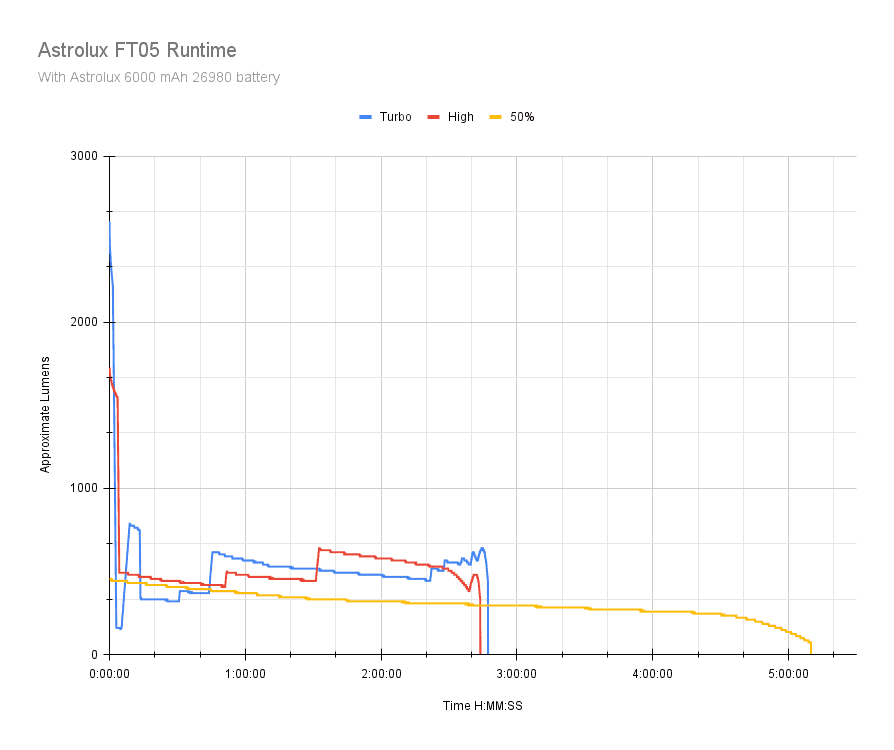
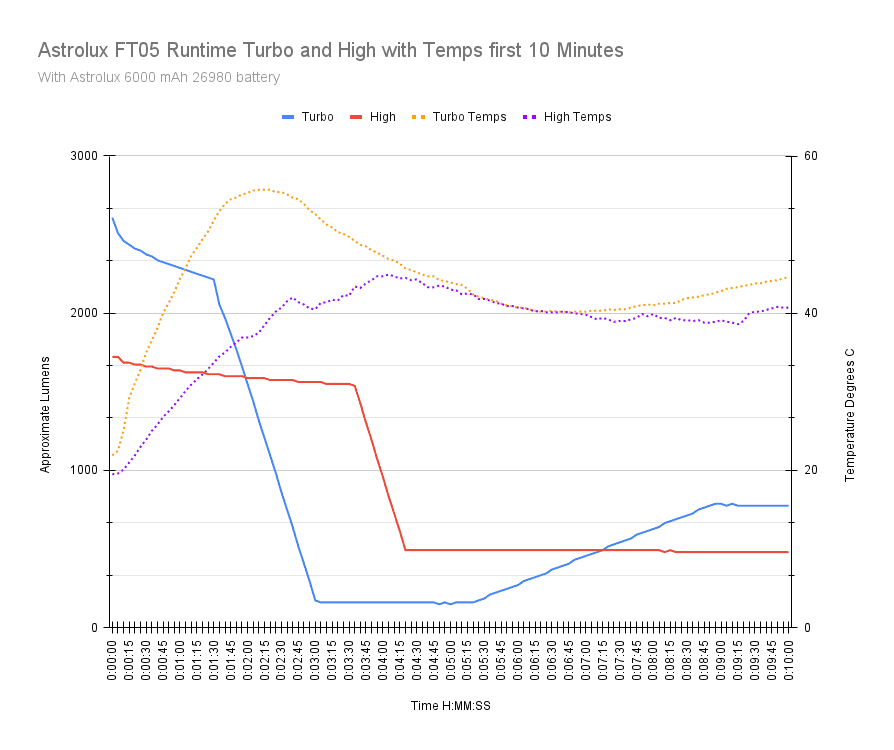
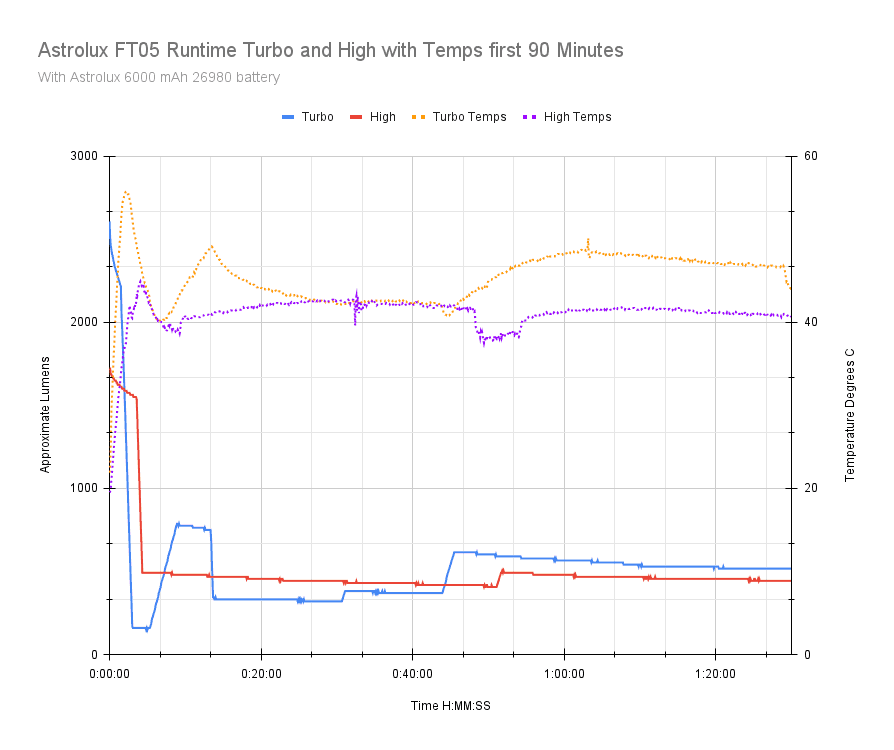
The comparison graph was interesting. I compared the Turbo output of some SFT-40-W lights, some SFT70 lights, and one Osram Boost HX (the Acebeam L19). The Fenix and Thrunites have boost drivers, the rest have buck drivers and we can see the difference between them on the output graphs. After about the 15 minute mark, they all maintain higher output, even the L19 which could only manage about half the initial output of the FT05. If Astrolux put a 8 amp buck driver in here and tweaked the ATR, this would be a nice light.
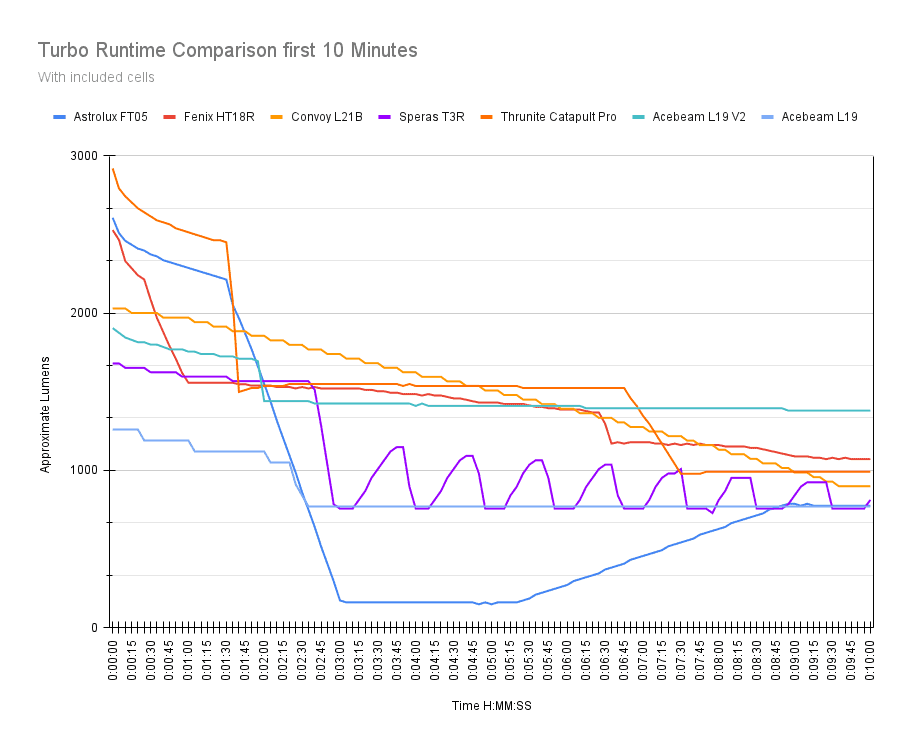
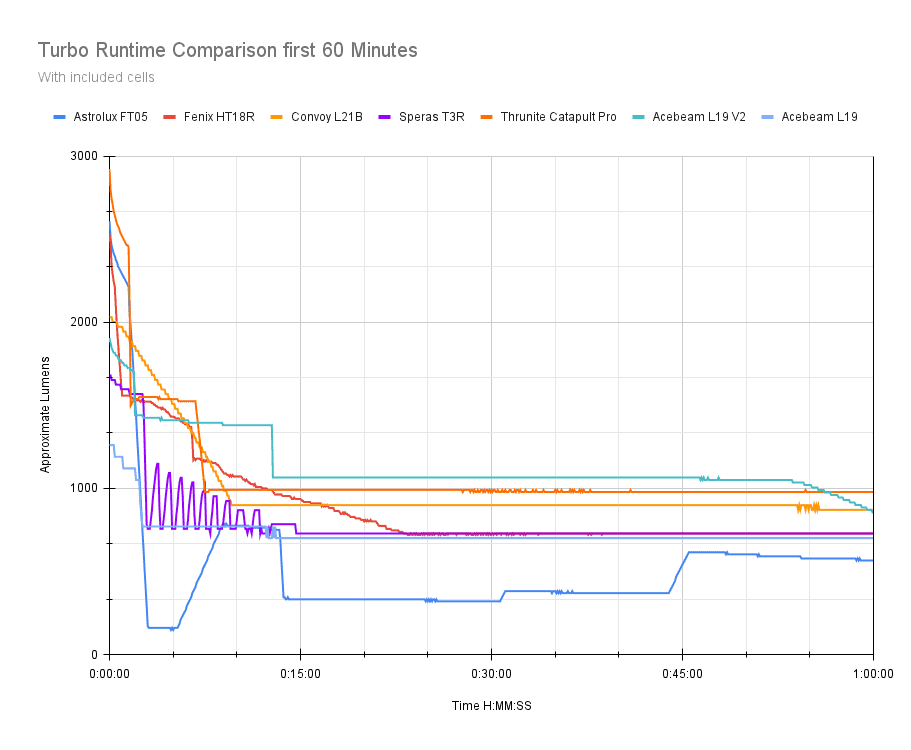
Peak beam intensity and beam distance measurements
About Peak beam intensity: Understanding ANSI FL1 Standards About peak beam intensity The calculated value of distance in meters at which the flashlight produces a light intensity of 0.25 lux. (0.25 lux is about the brightness of a full moon shining on an object). This means that the intensity has decreased so much, it becomes difficult to see darker objects, or objects that don’t reflect light. The columns ‘Meters’ and ‘Yards’ use rounded numbers.Beam distances are measured using a Uni-T UT383S luxmeter measured indoors at 5 meters using the included fully charged 26980 battery. Measurements taken at 30 seconds.
| Mode | Specs | Candela measured | Meters | Yards |
|---|---|---|---|---|
| Low | ? | 3725 cd | 122 | 133 |
| High | ? | 136,550 cd | 739 | 808 |
| Turbo | 124,300 cd | 185,525 cd | 861 | 942 |
| Turbo at start | ? | 208,975 cd | 914 | 999 |
Obviously, my Turbo figure trounces the Astrolux figure. Maybe Astrolux accidentally measured the High mode for the throw instead of Turbo? To be fair here, the Mateminco A1 counterpart advertises (over at Nealsgadgets) 1058 meters of throw, which is closer to my figures. At start, Turbo is over 200 kcd and 914 meters. Either way, for a reflector roughly the size of a C8, this is outstanding and shows this LED has really high intensity.
Beamshots
Camera settings and distance: Photos taken with a Canon EOS R100 with Canon RF-S 18-45 mm STM lens. The camera is set to 0.3s, f5, ISO 1600, and 5000K WB. The fence is 40 meters distant.For the water tower at 950 meters, the camera is set to 0.5s, f4.5, ISO 1600, and 5000K WB.
Beamshots of the following flashlights compared at 40 meters:
- Astrolux FT05
- Olight Warrior X4
- Olight Seeker 4
- Fenix TK20R UE
- Wurkkos TD01C
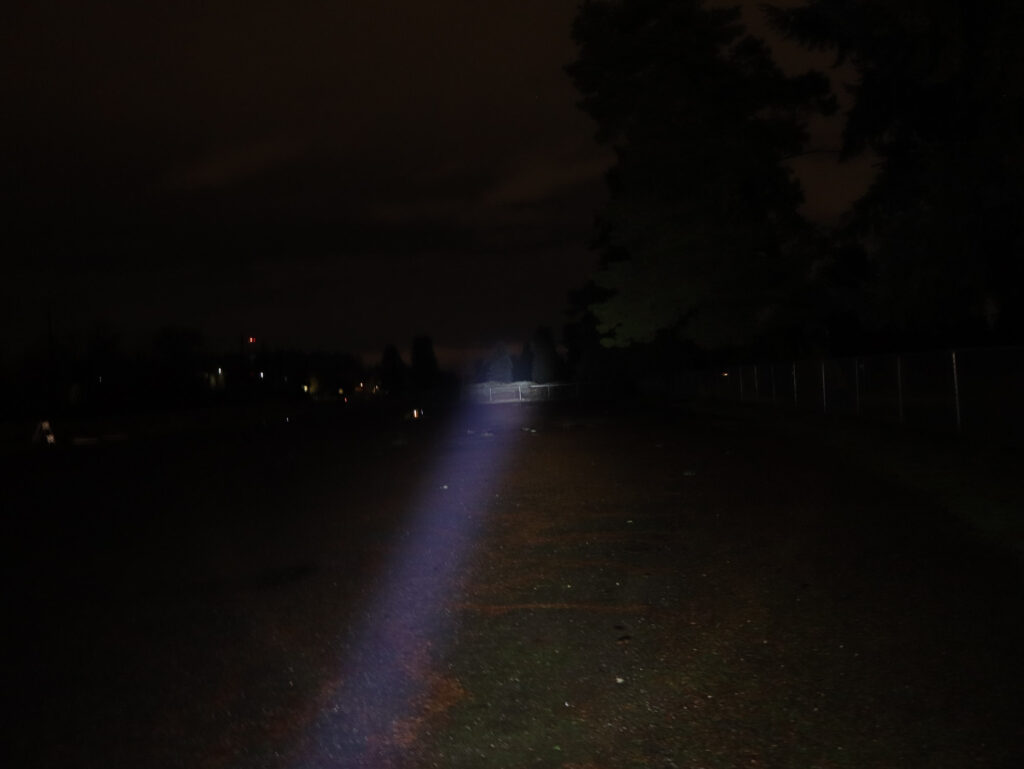

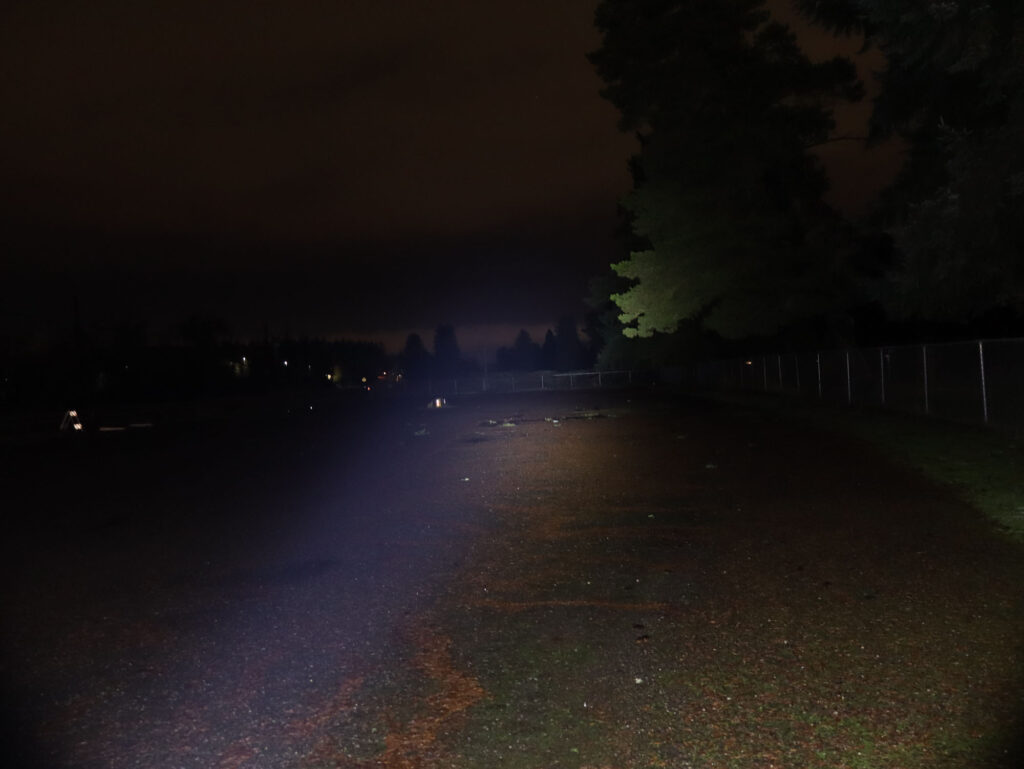

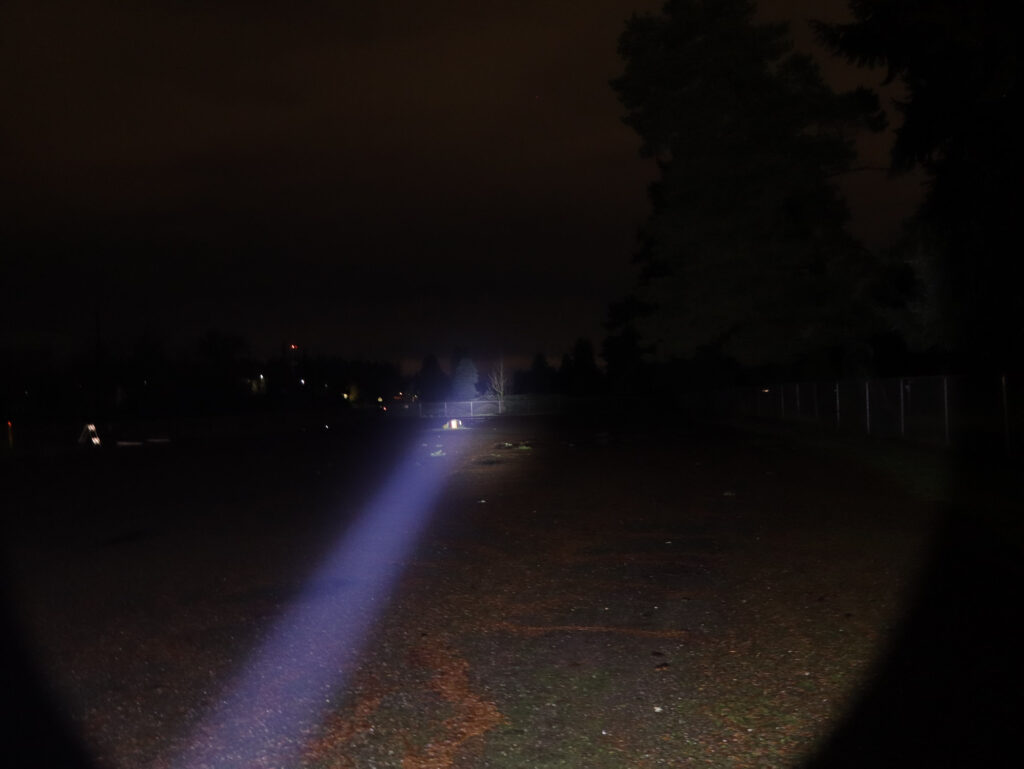
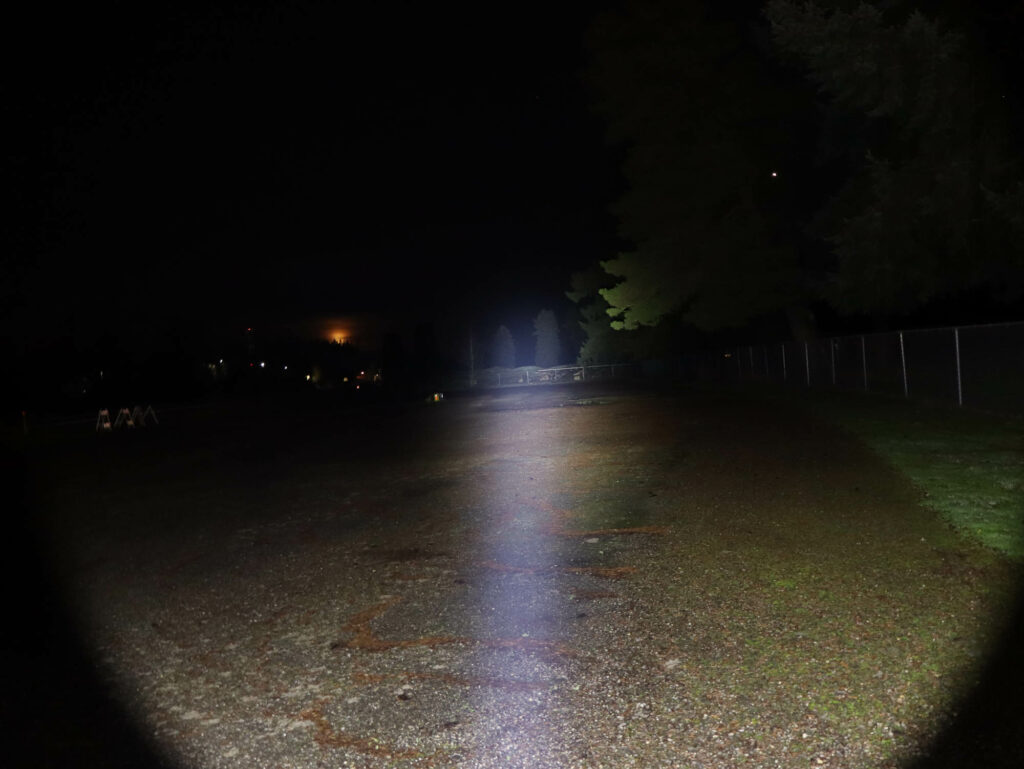
Beamshots of the following flashlights compared at 950 meters:
- Astrolux FT05
- Wurkkos TD01C
- Thrunite Catapult Pro
- Convoy L21B
- Fenix HT18R

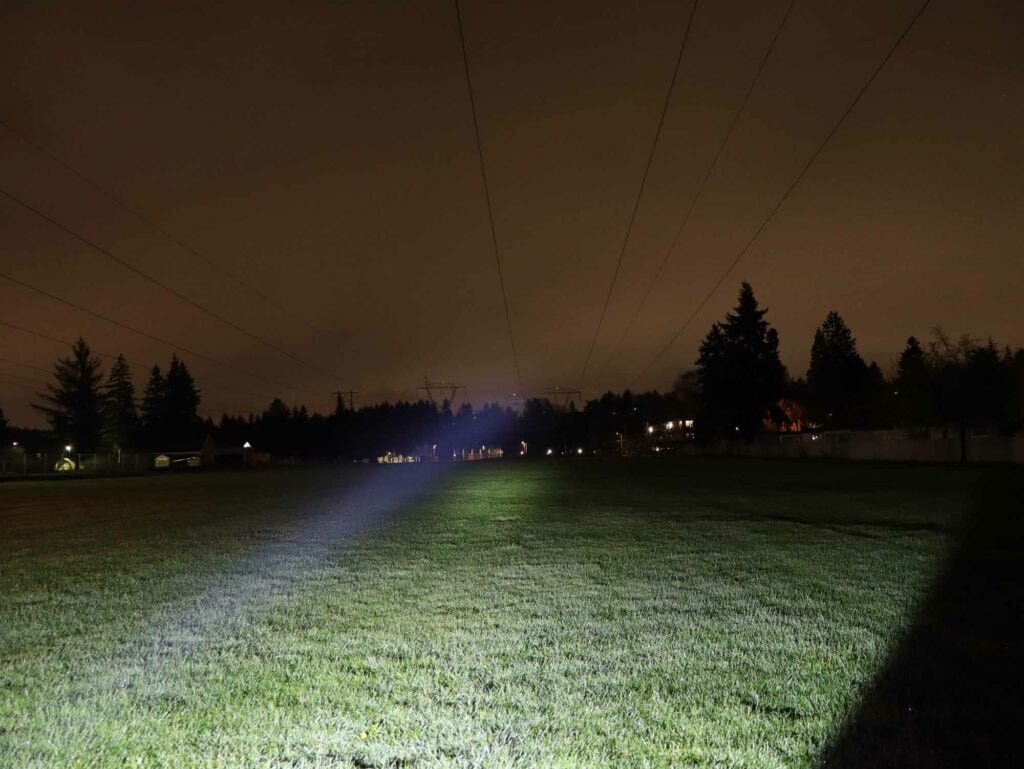

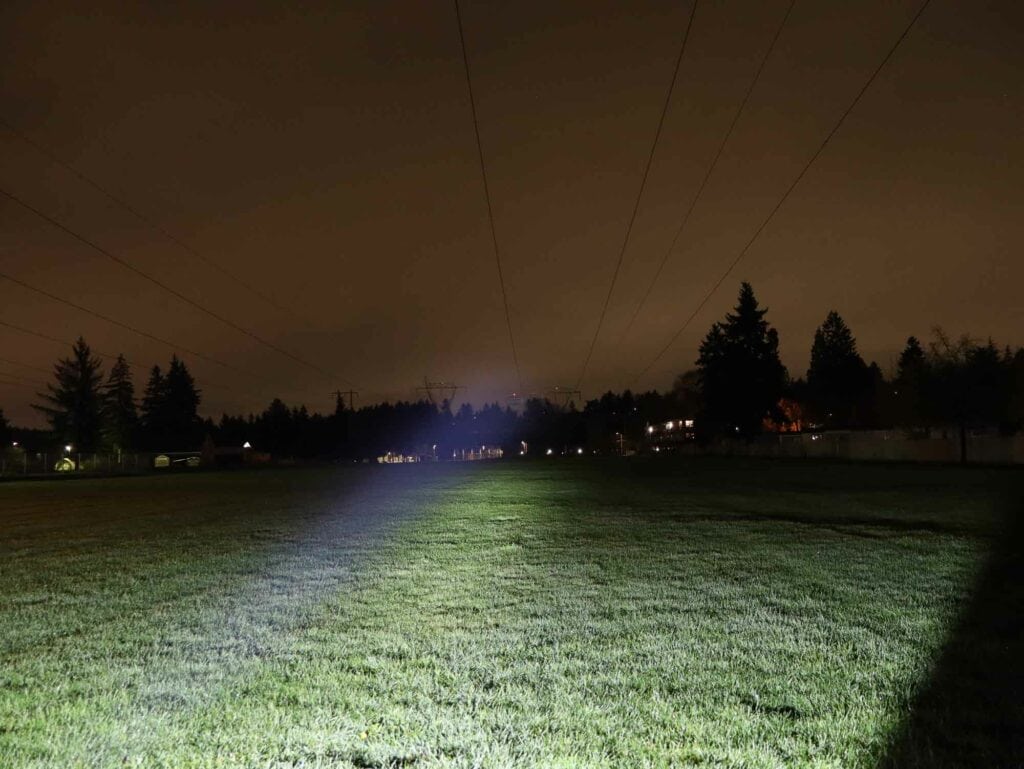

Please note that the following beamshots are mainly intended to showcase the beam pattern and beam quality, rather than overall performance. These images are typically taken directly after activation, and in different seasons or weather conditions, and therefore do not fully represent its overall performance. For accurate performance metrics, such as output, beam distance, and runtimes, you need to look at the performance section of this review.
Disclaimer: This flashlight was sent to us for review at no cost by Banggood. We have not been paid to review, nor have we been holding back on problems or defects.
Final Verdict
Pros
- Affordable
- High output
- Great beam distance
- QUSB type C charging with power bank
- High capacity battery
Cons
- Unregulated driver
- Turbo steps down to under 200 Lumens
- Unimpressive, nonstandard battery size with no factory adapters or tubes
- Ramping needs tweaking
Explanation on star ratings:
1: Avoid: a match would be a better choice – 2: Poor: significant defect or issues; almost unusable – 3: Average: some defects or issues; but still usable 4: Good: recommended (minor issues) – 5: Great: highly recommended

3.5 stars: ★★★⋆
While our star rating provides a reliable indicator, we encourage you to read the full review to make an informed decision based on your own needs and preferences.
Another Astrolux review in the books, and it’s more of what I’ve encountered on previous Astrolux lights: Generally it’s good, and overall, this FT05 both surprised and disappointed. I liked the compact size and form factor, simple design, and nice handling. I also liked the high output and the very impressive beam distance from a C8 size reflector. The UI is also simple and Anduril-like.
While I appreciate flashlight manufacturers trying out new things, I question Astrolux’s logic in sticking an uncommon battery in this flashlight and not offering adapters. If the cell goes bad, you’re stuck with a warranty return and no flashlight instead of just swapping in another battery with an adapter. The workaround of that is if you own other 26650 size Astrolux lights with the same thread pitch, but that’s arbitrary here since it requires you to own those lights already. While the FT05 has nice qualities, the driver is a simple FET+1 and the thermal regulation is rubbish. While the UI is simple and works, it’s the same unintuitive and obtrusive ramping I see on other Anduril-like UIs. All of these negatively affect usefulness, so it’s showing in my rating here.
If Astrolux are reading this: Put in a regulated driver, include adapters (or a shorter battery tube for 26650 or 21700), and tweak the UI a bit and you’ll have a winner! Should you get one? If you want a unique light with a ton of throw and pretty decent output in an un-thrower-like package, give the FT05 a look. It’s certainly a unique flashlight with room for improvement. I’m giving it 3.5 stars.
Buy your Astrolux FT05 with a discount
1lumen selects and reviews products personally. We may earn affiliate commissions through our links, which help support our testing.